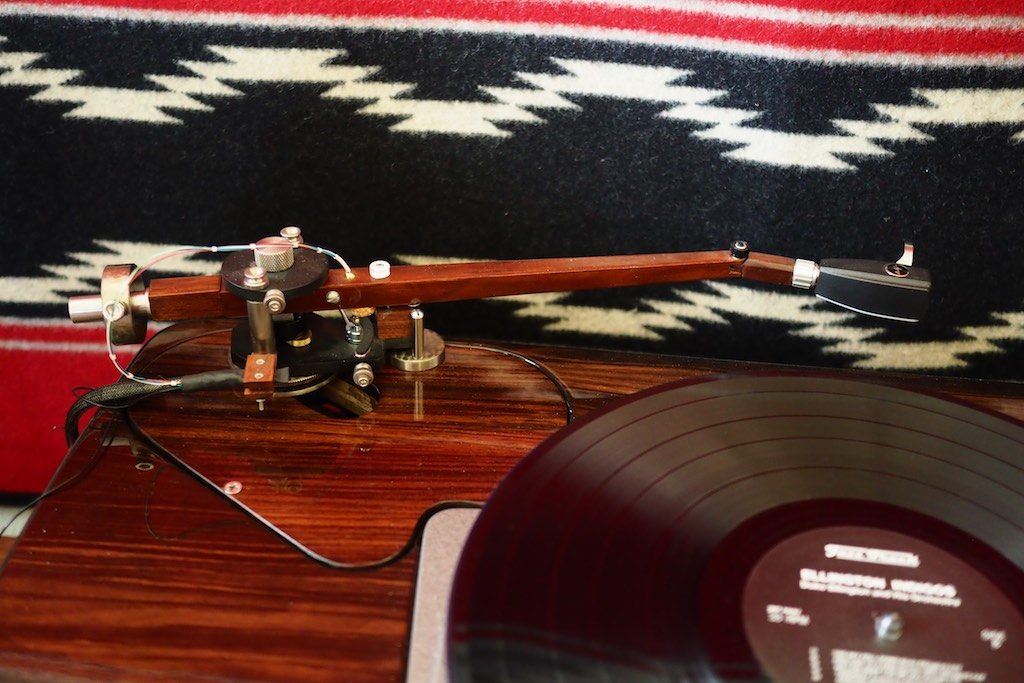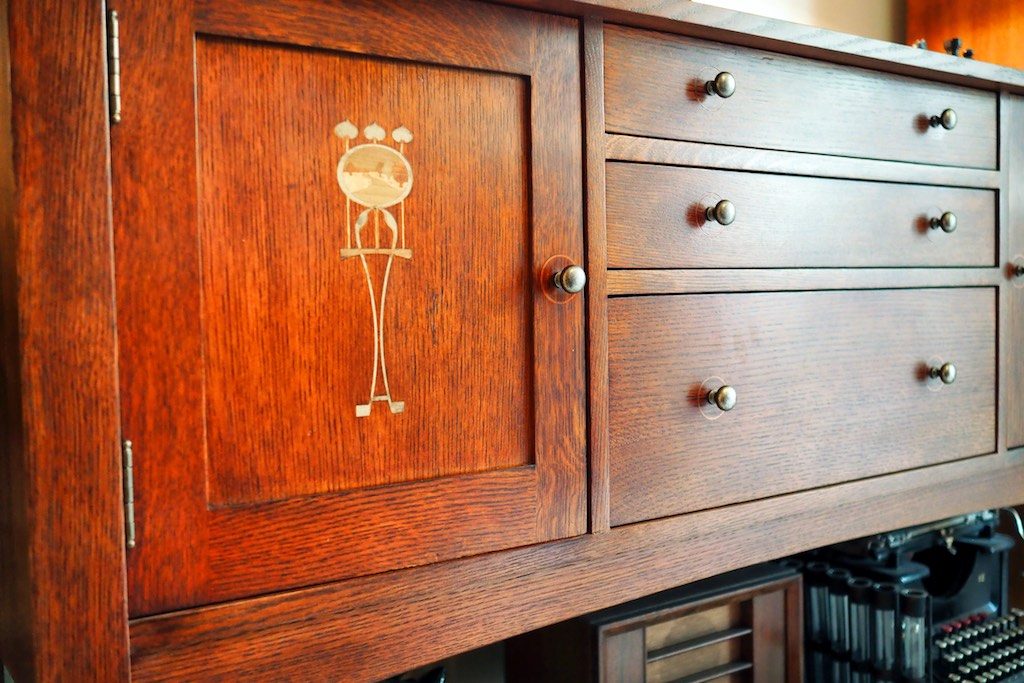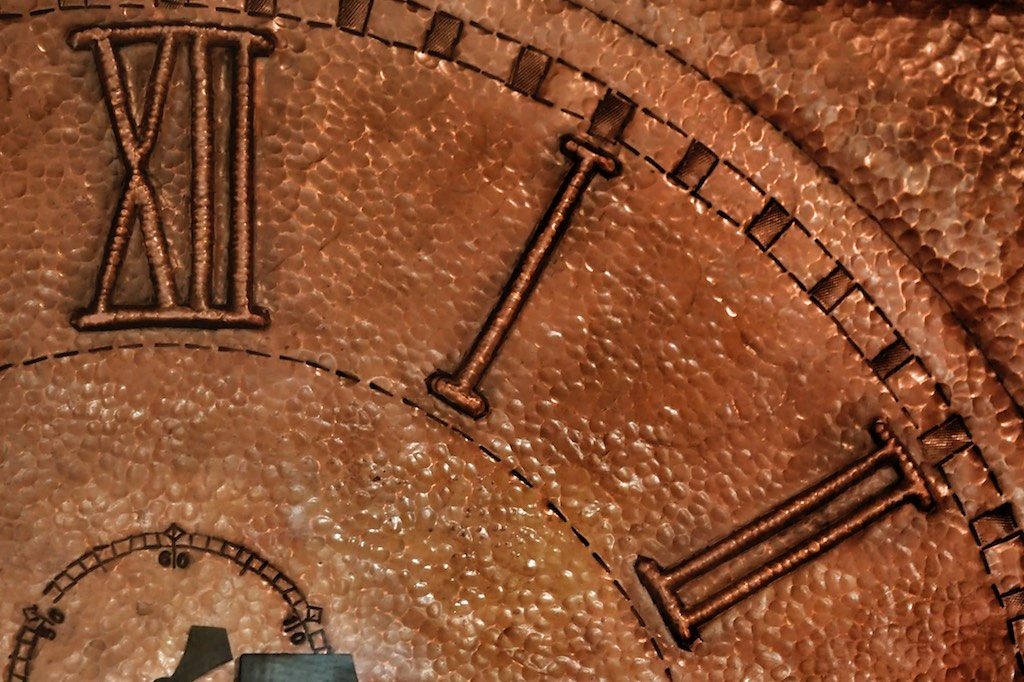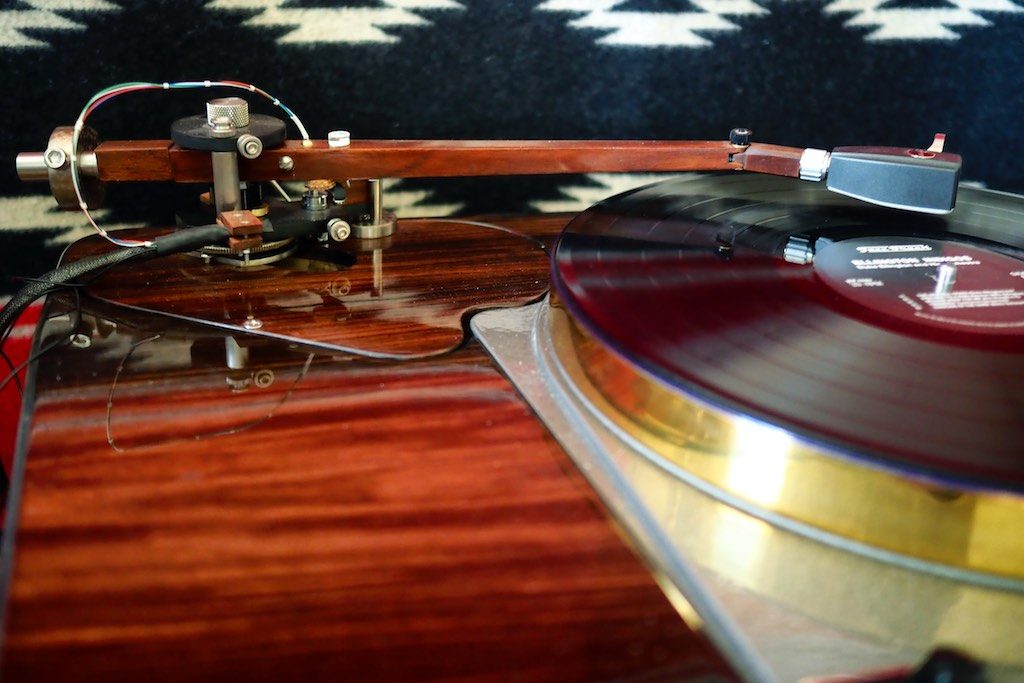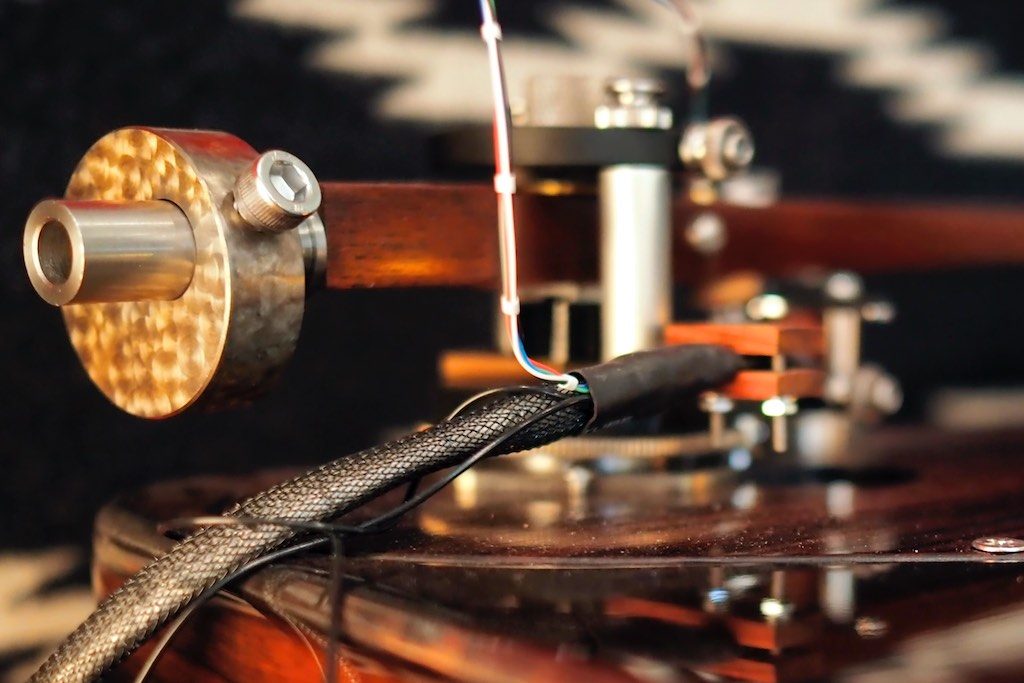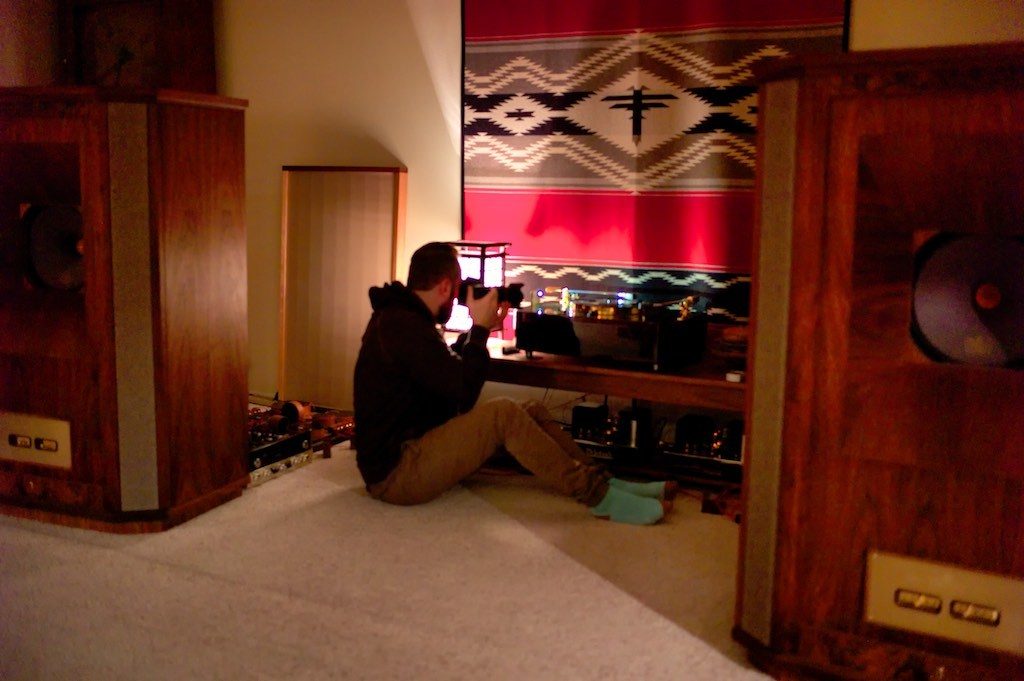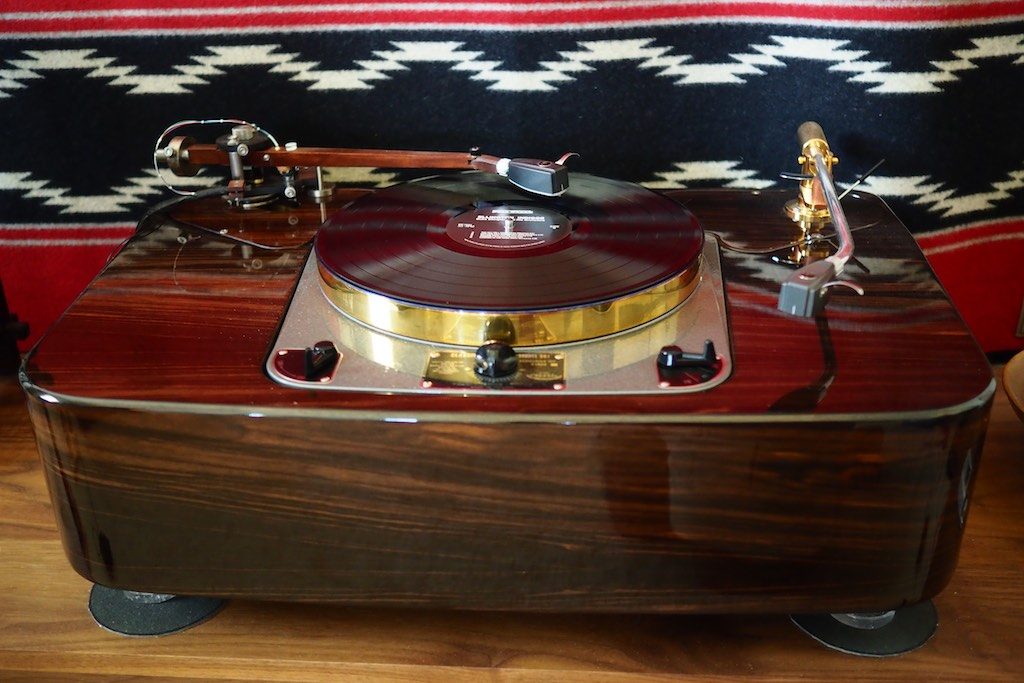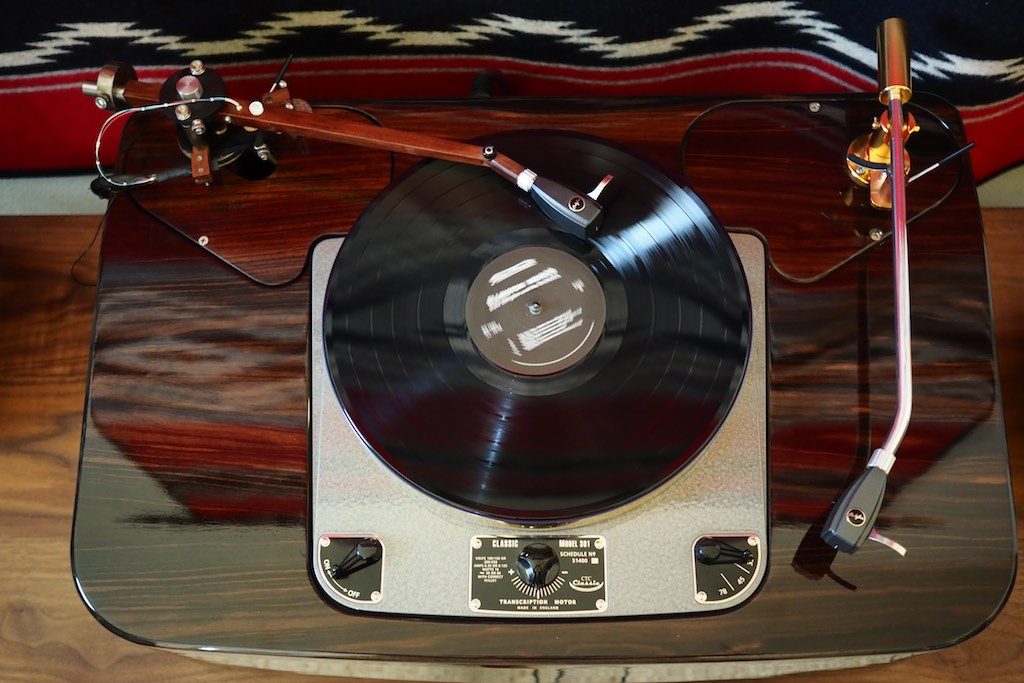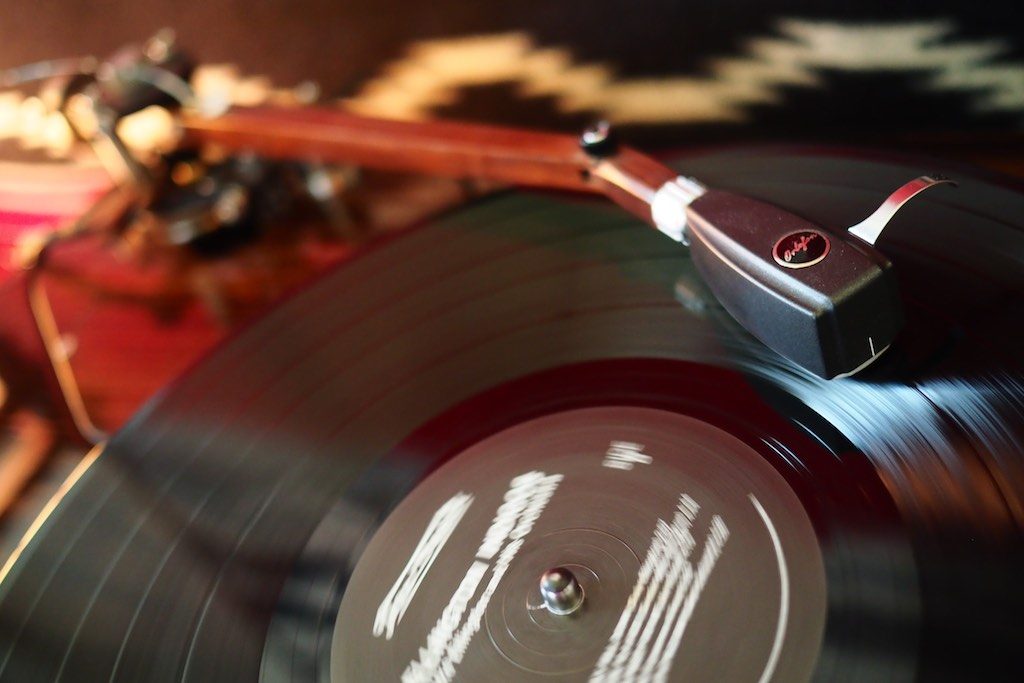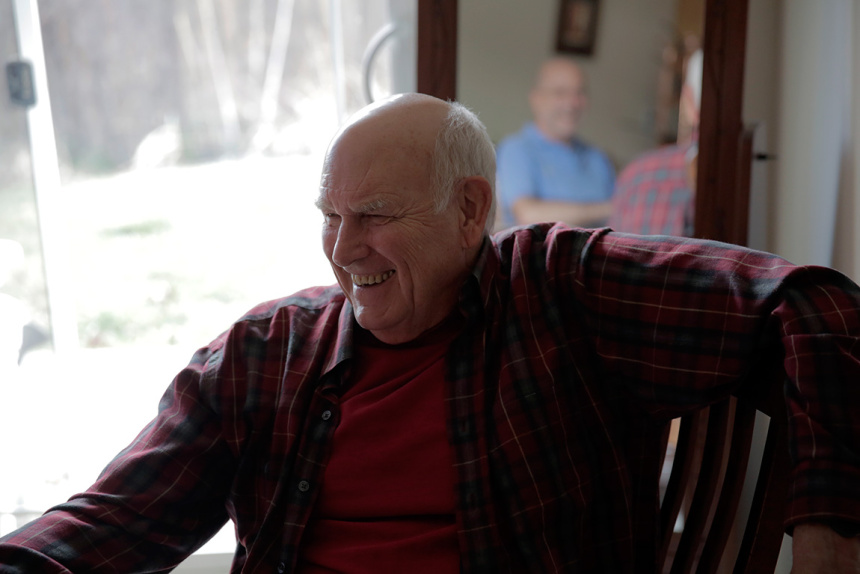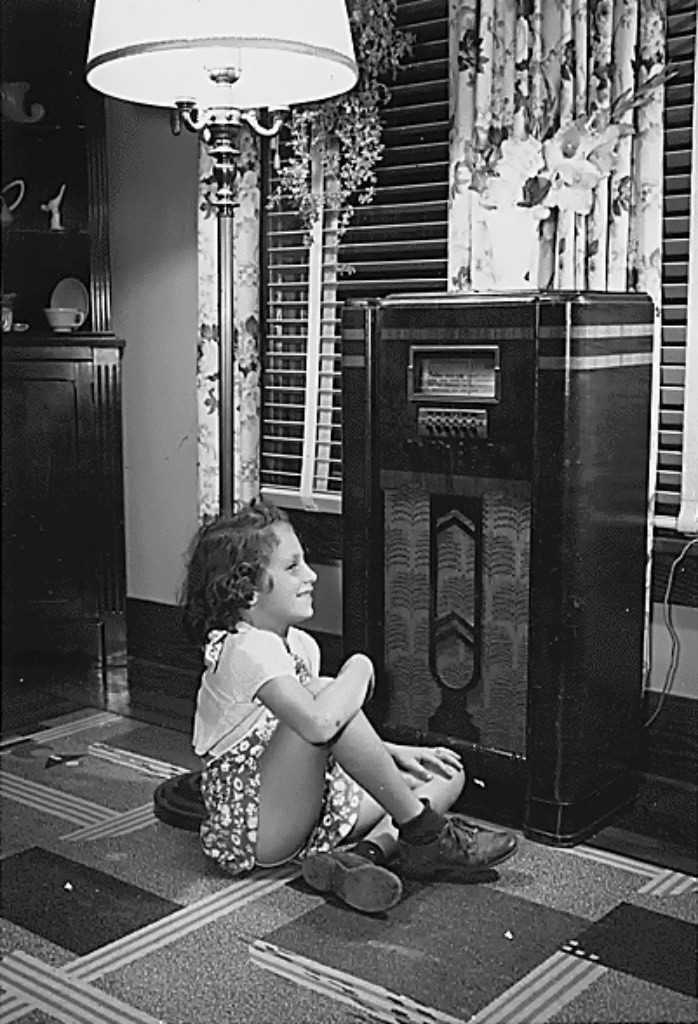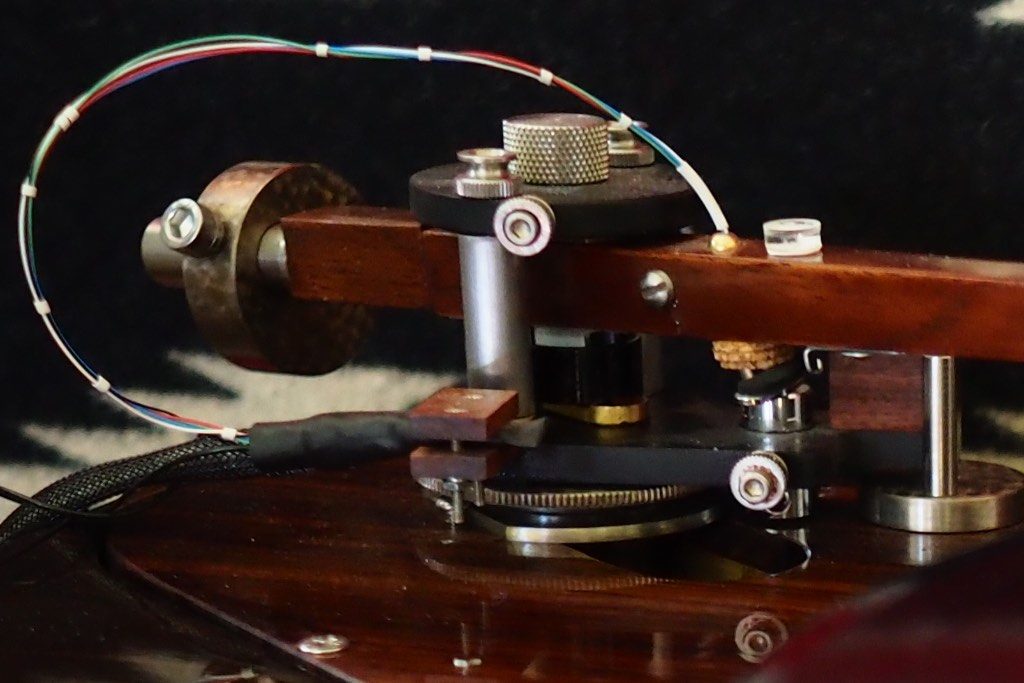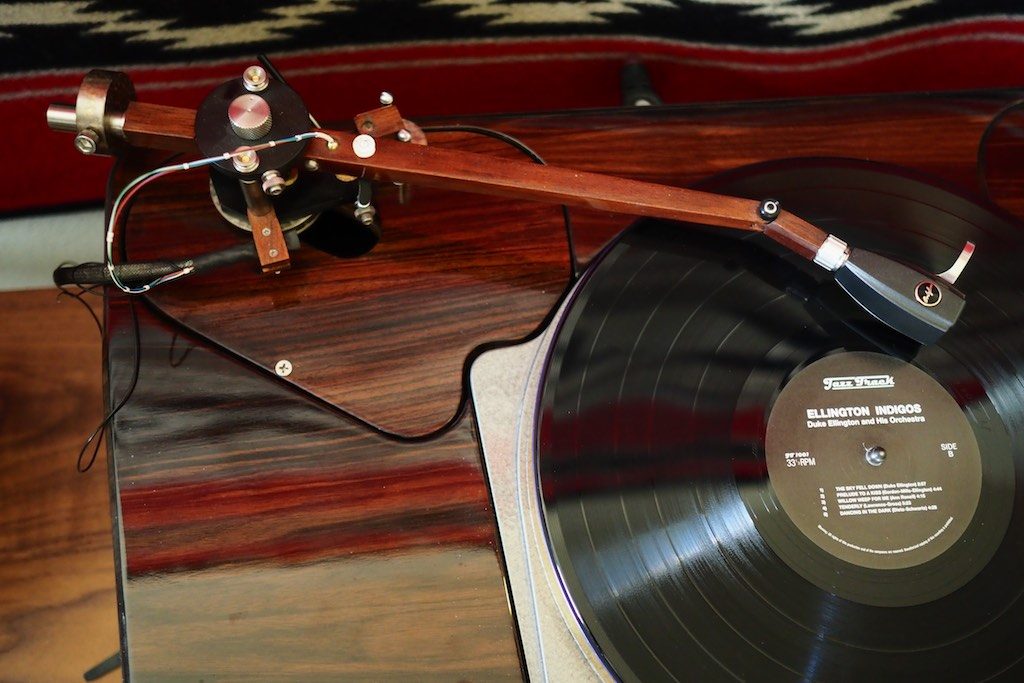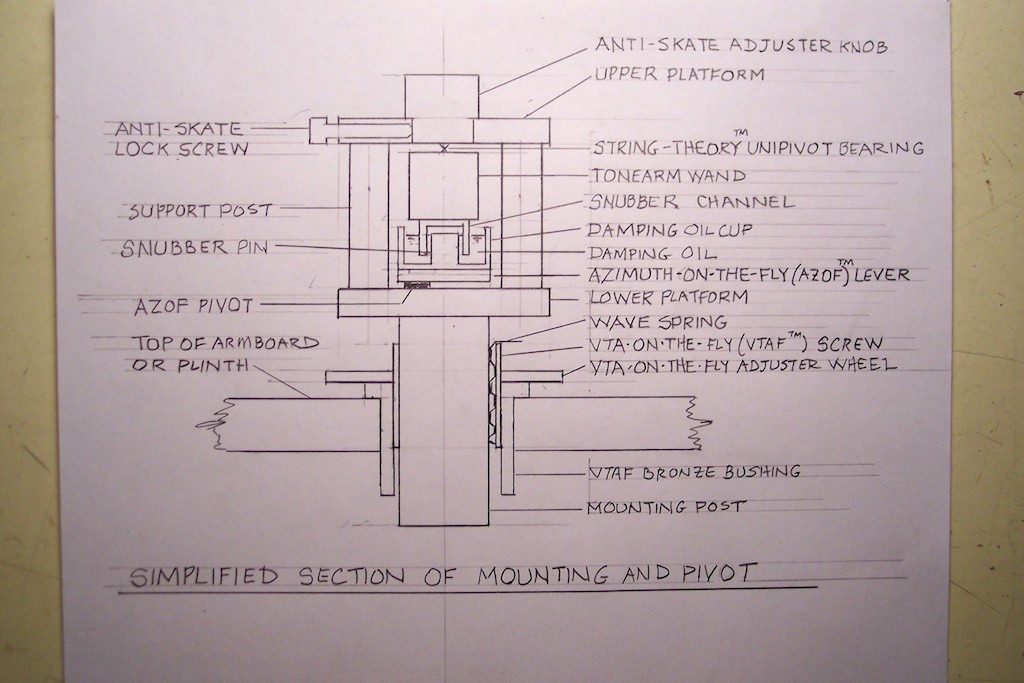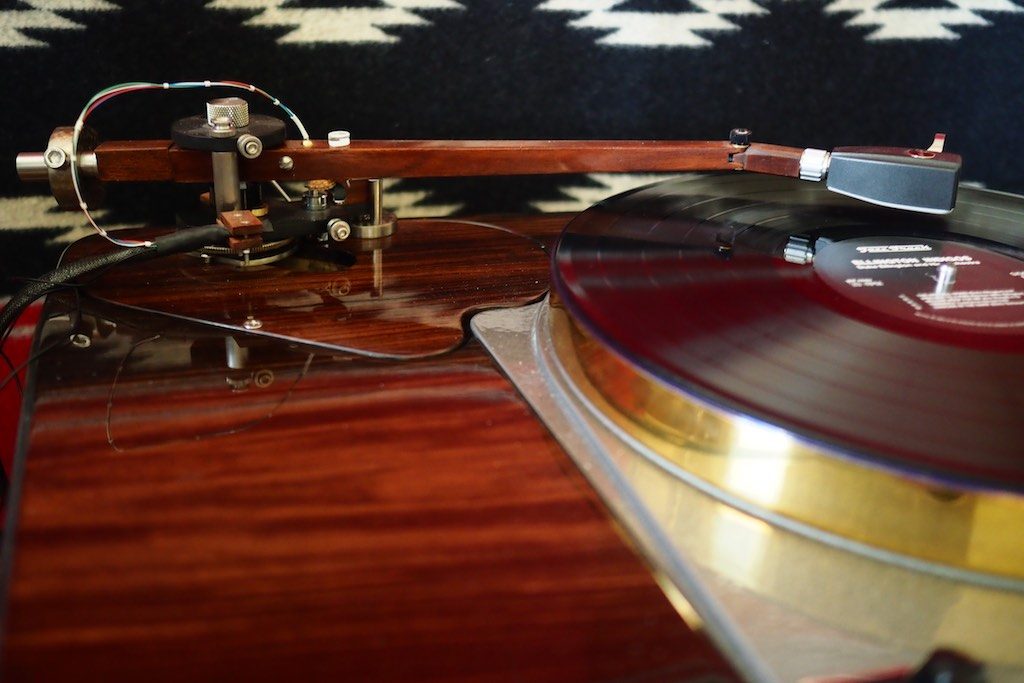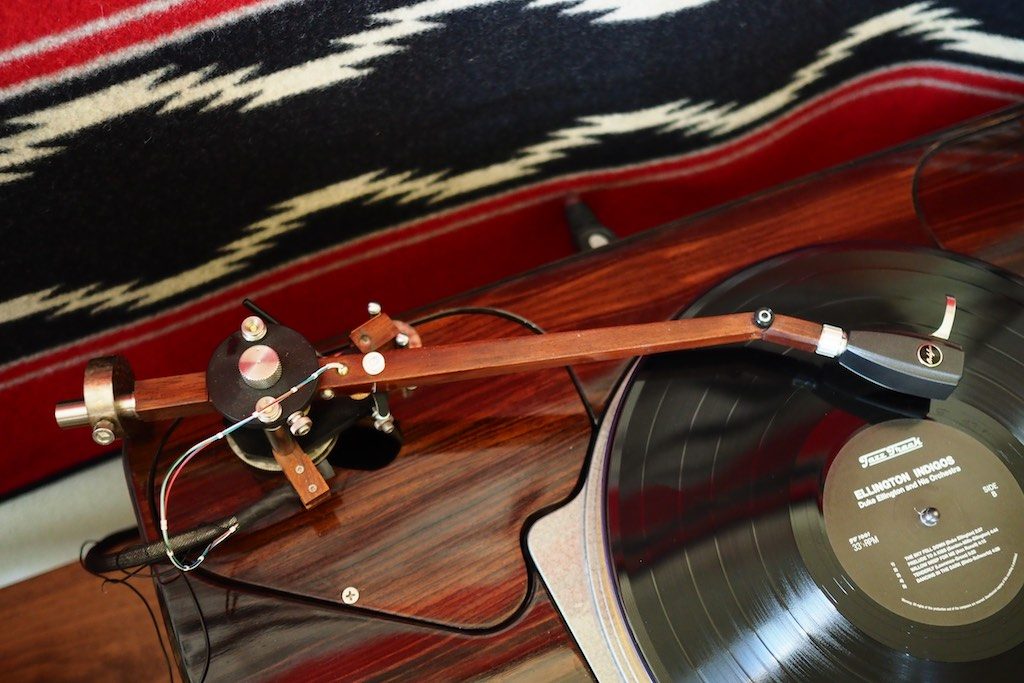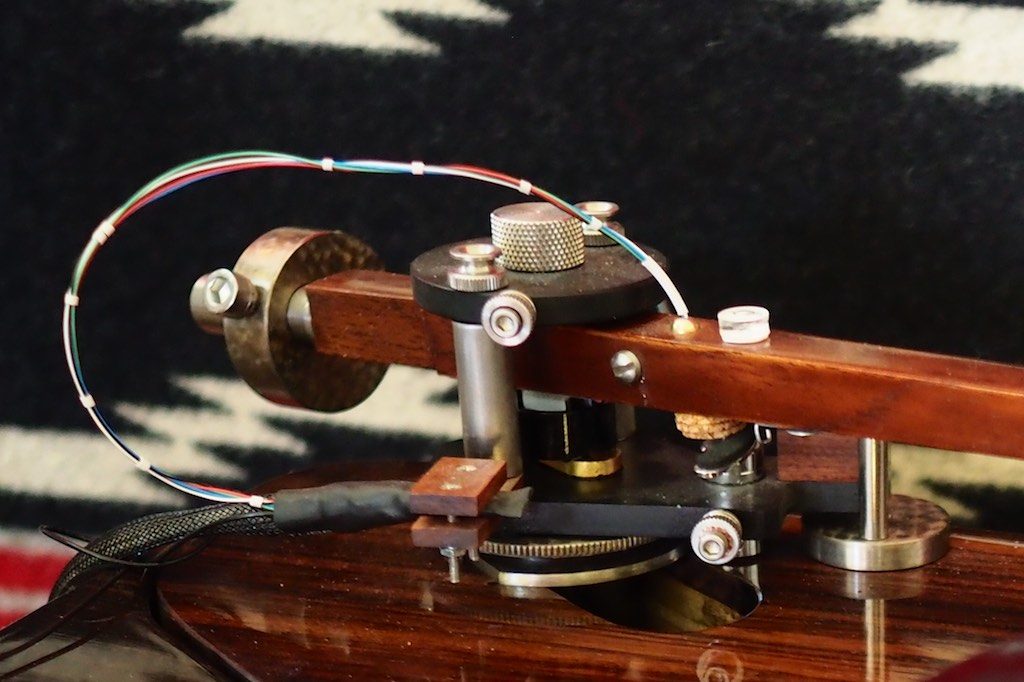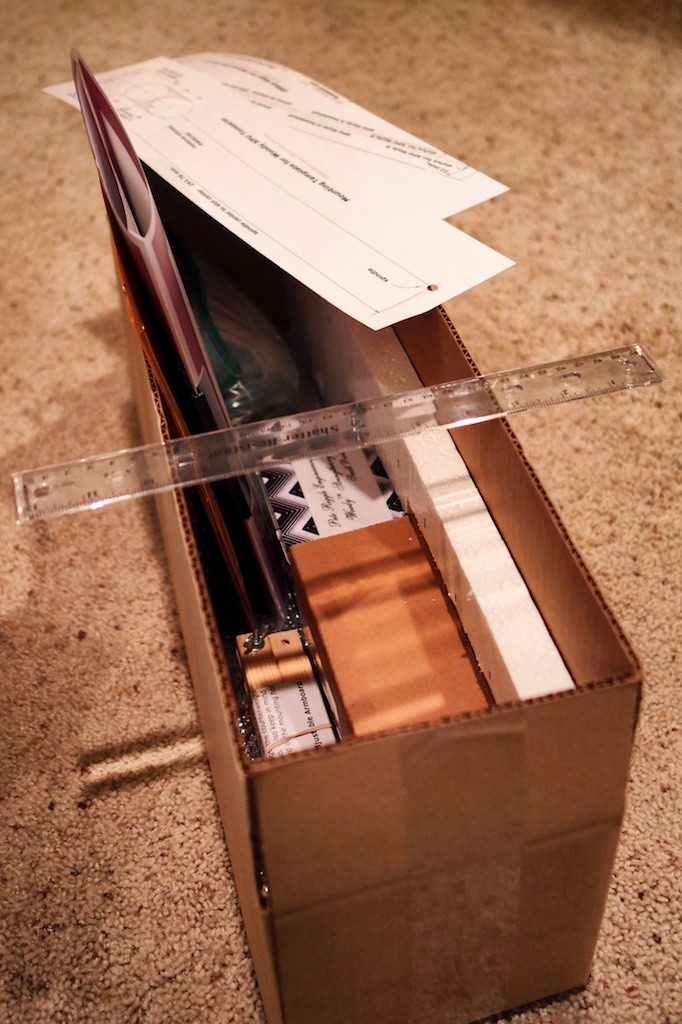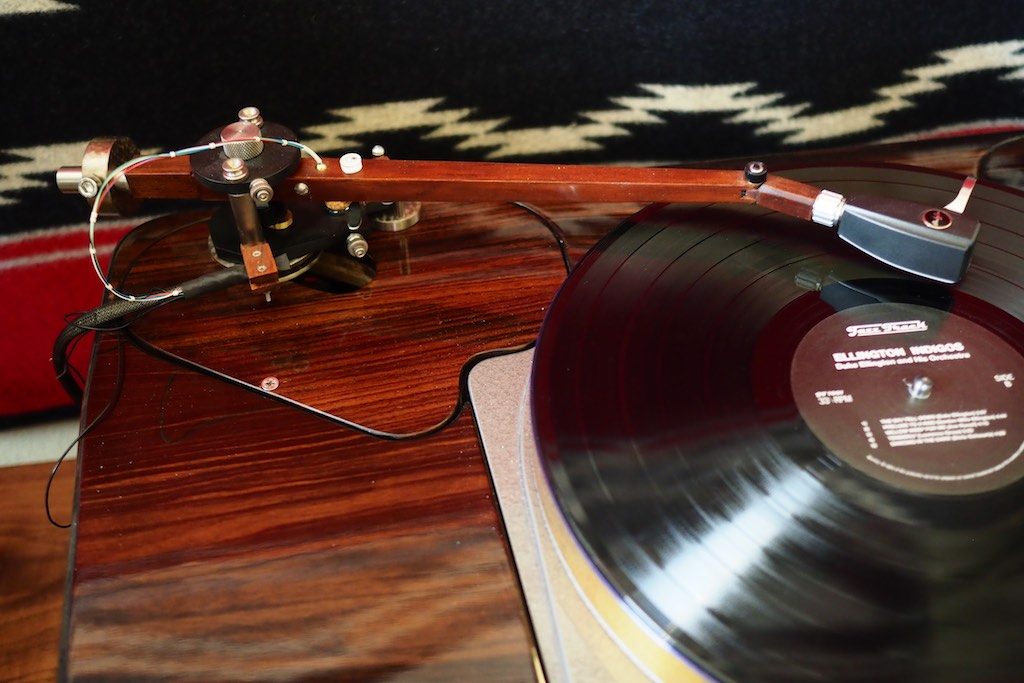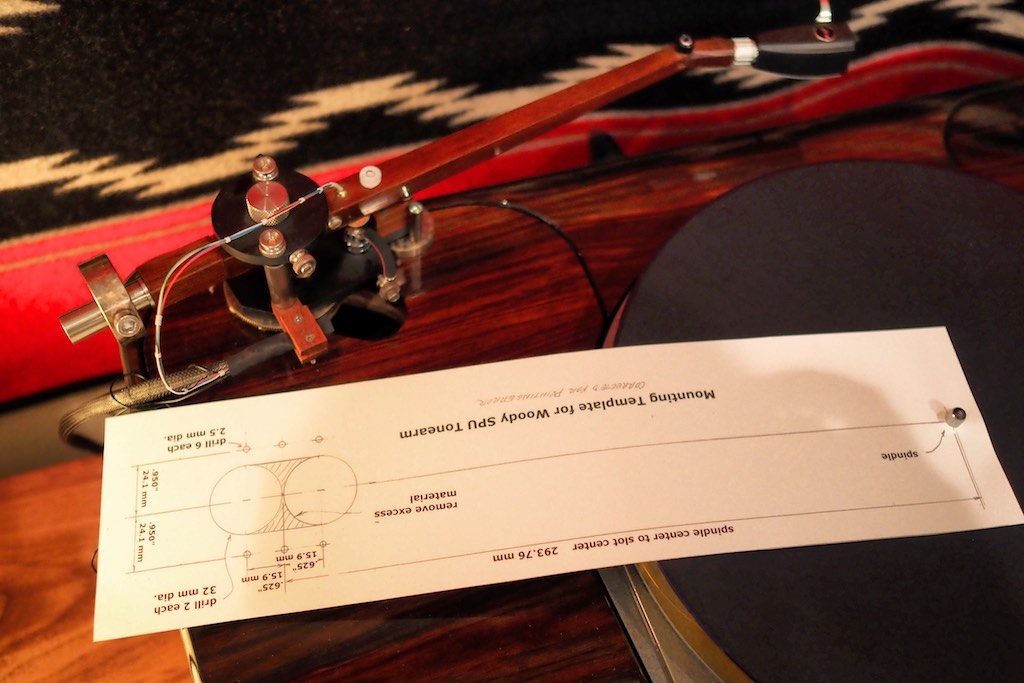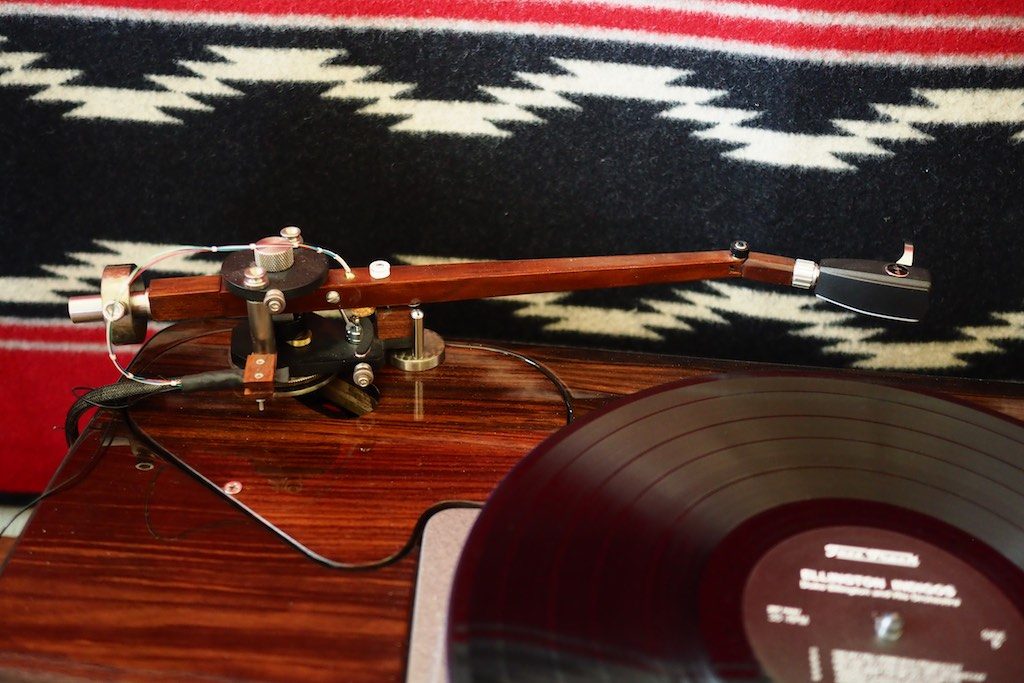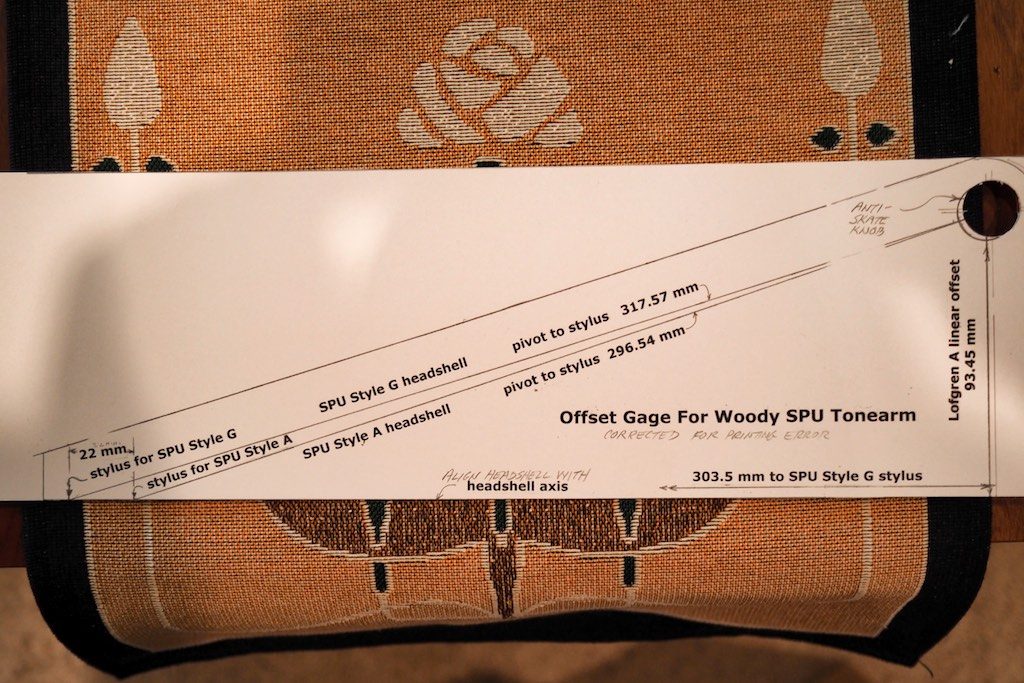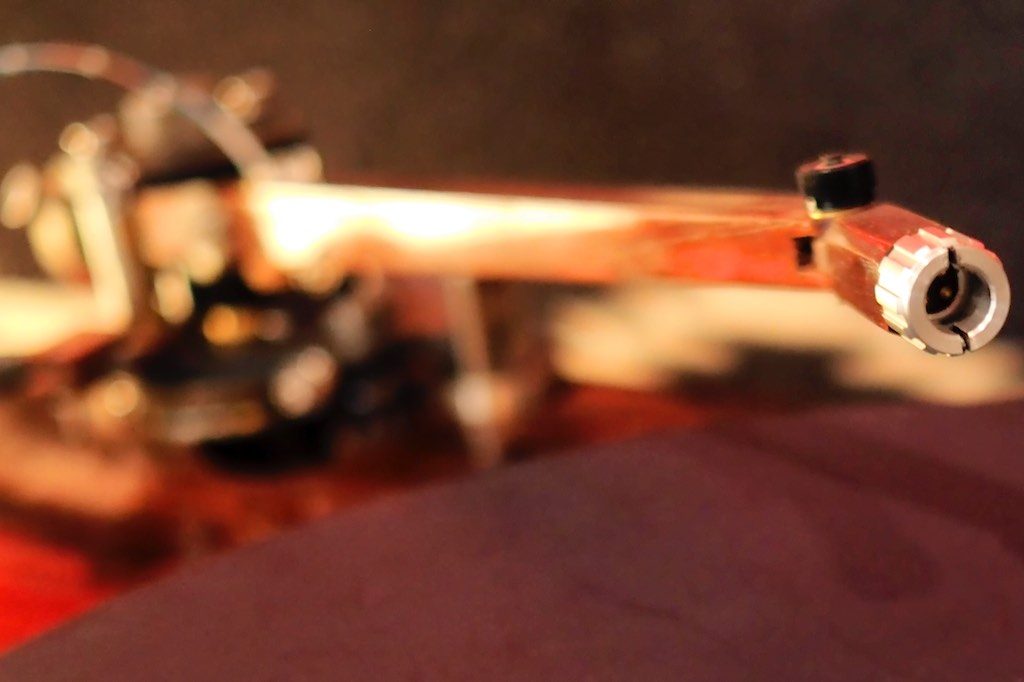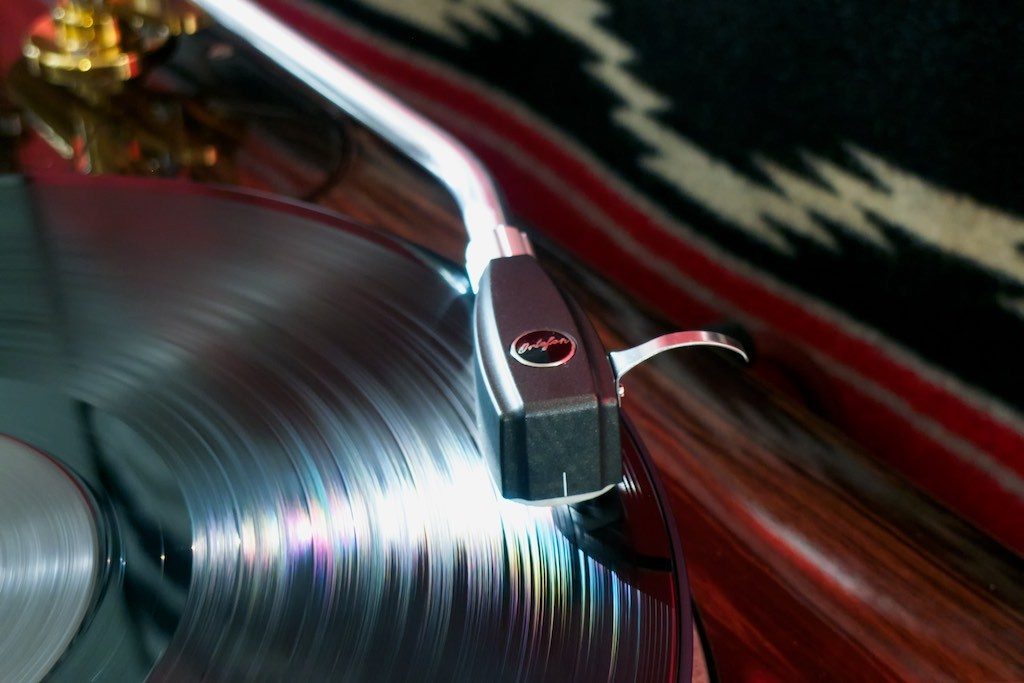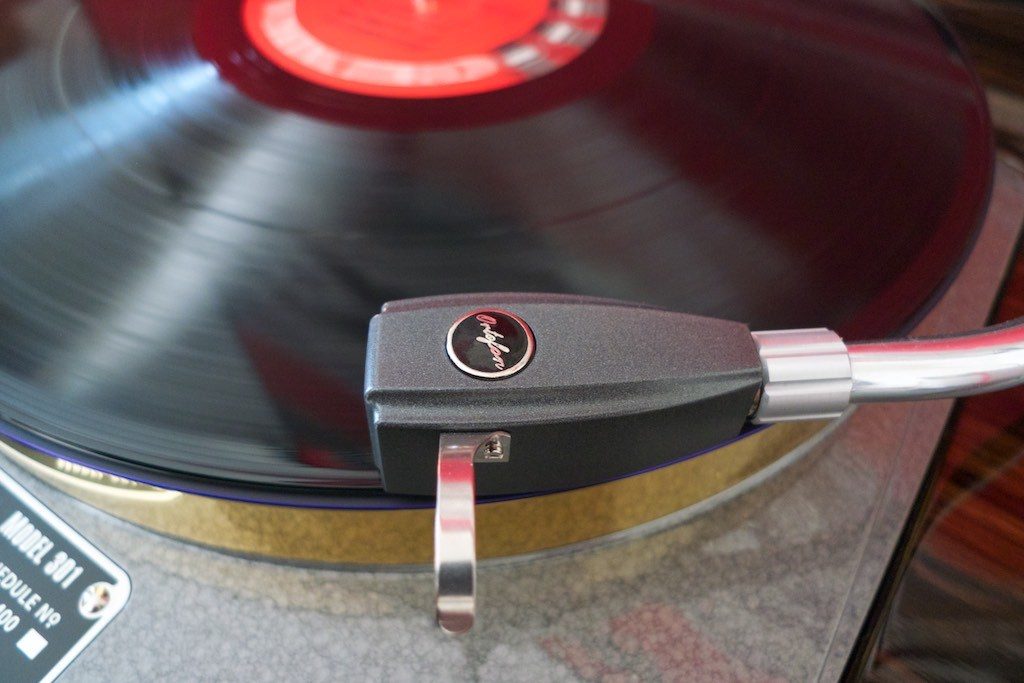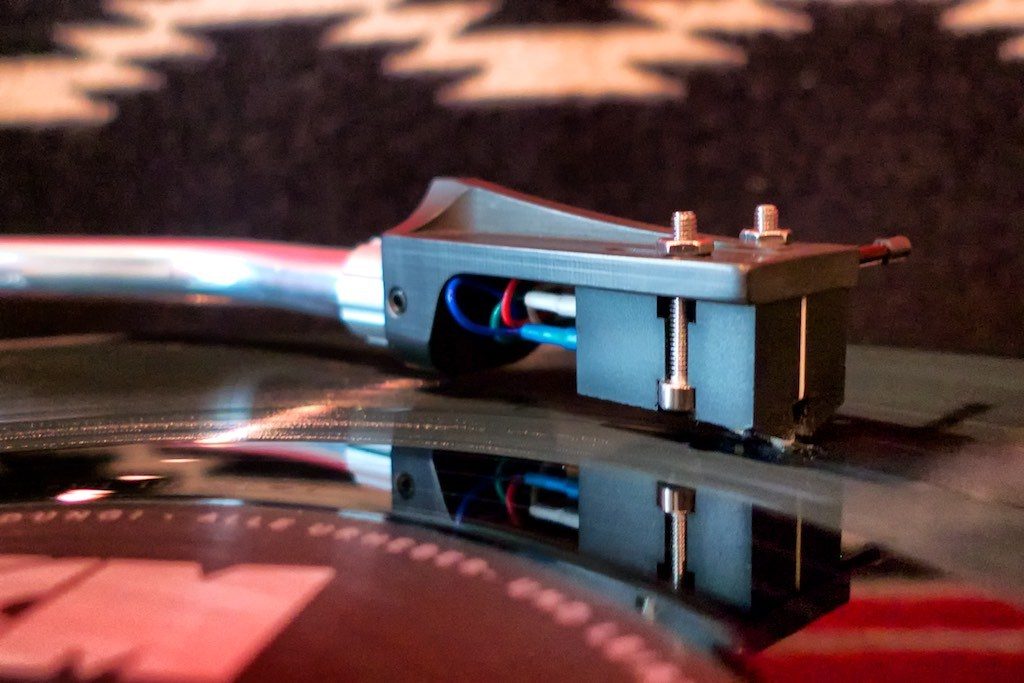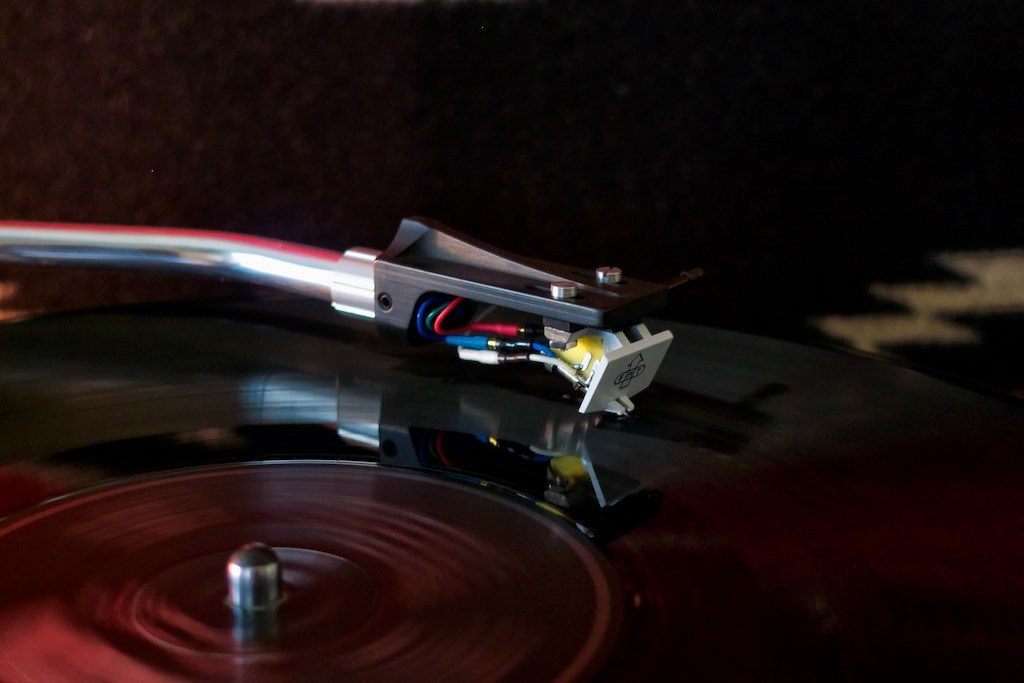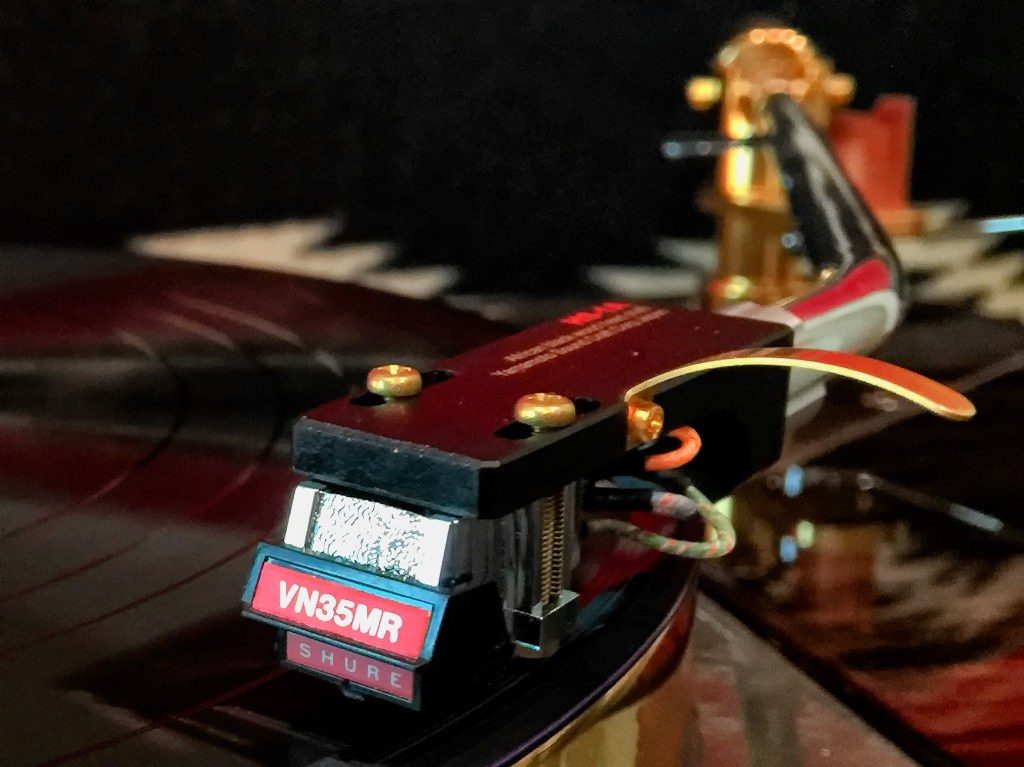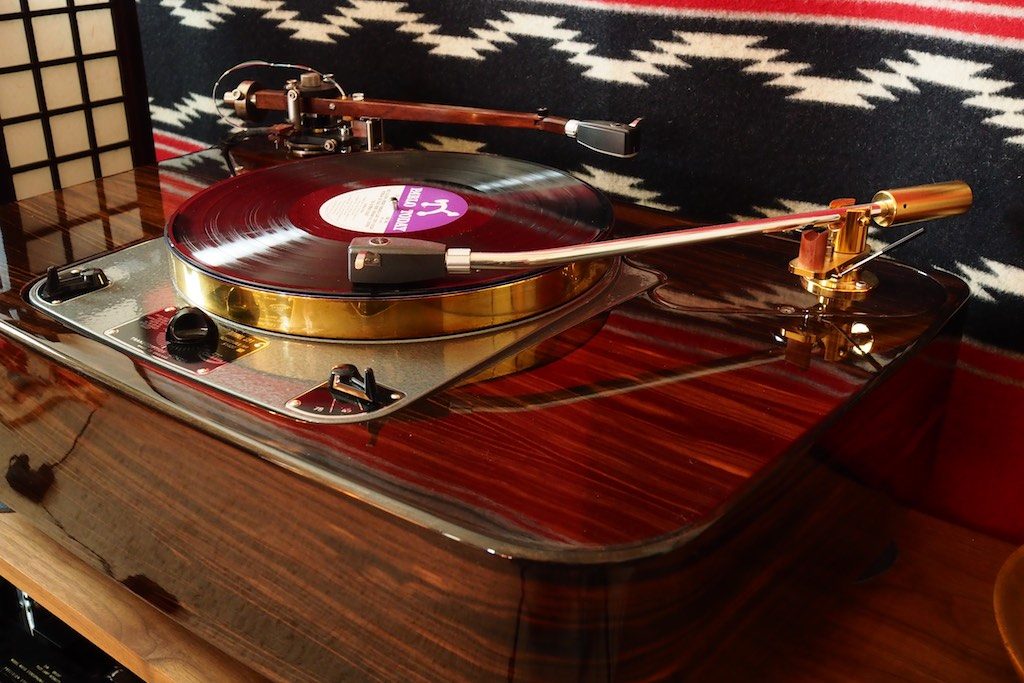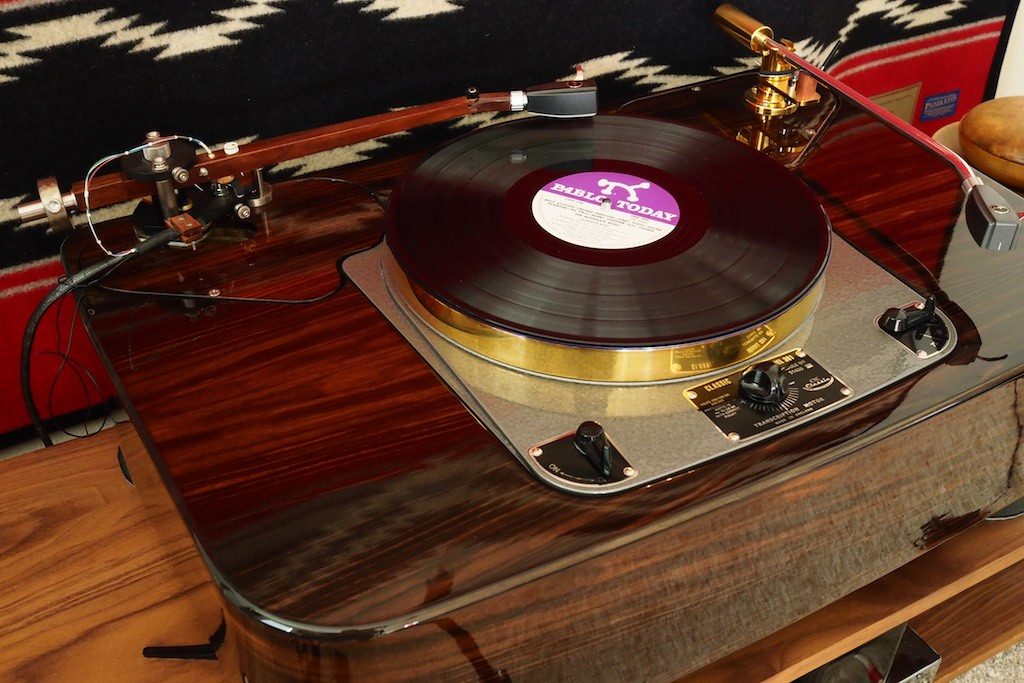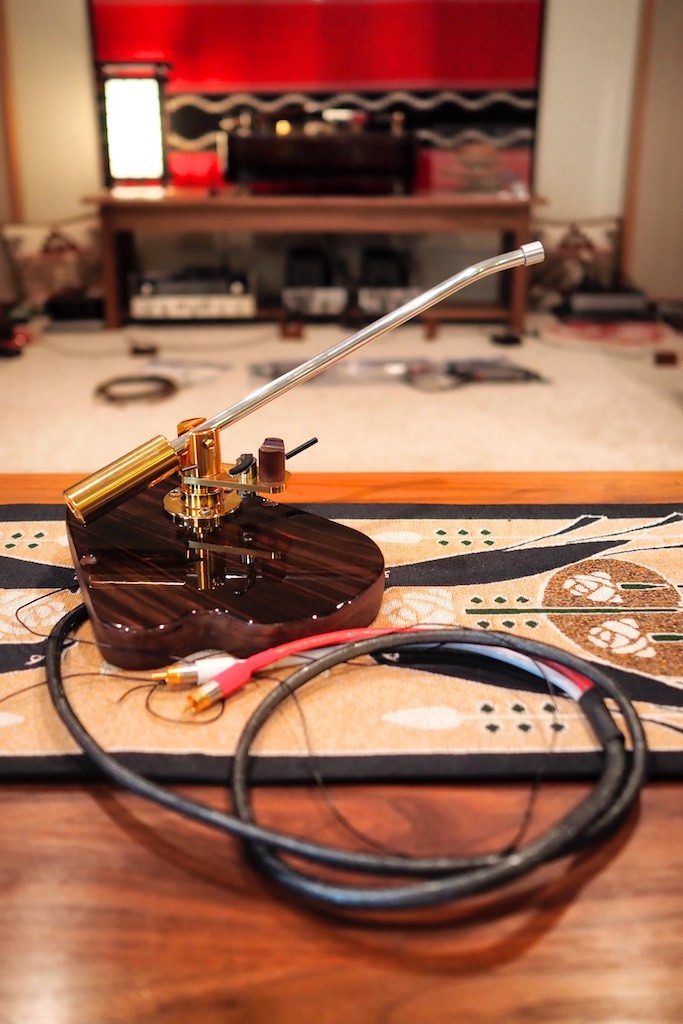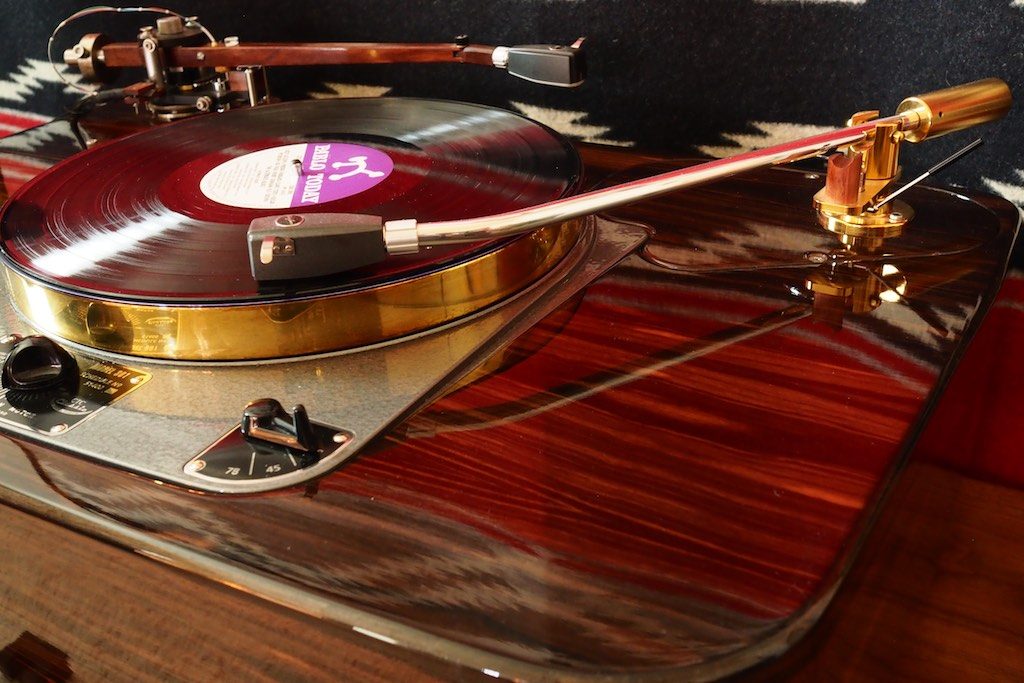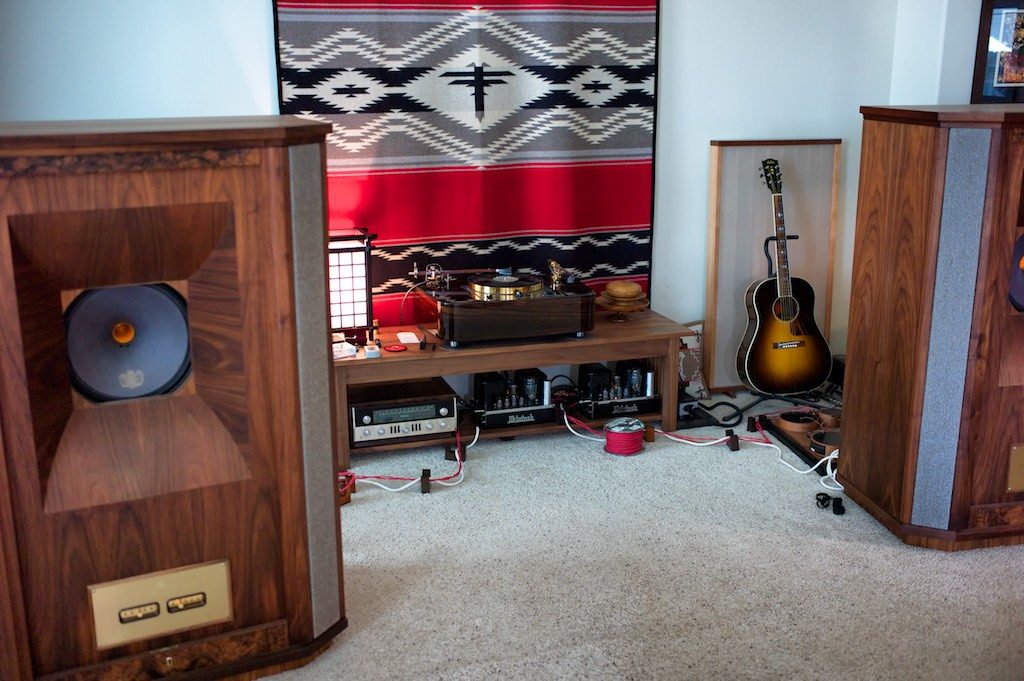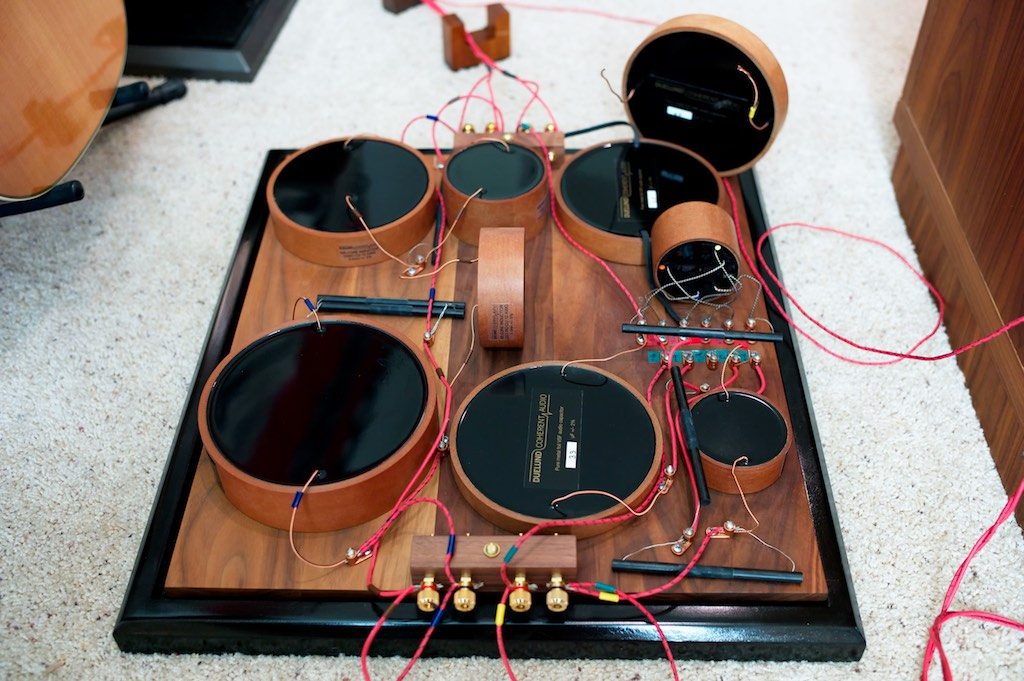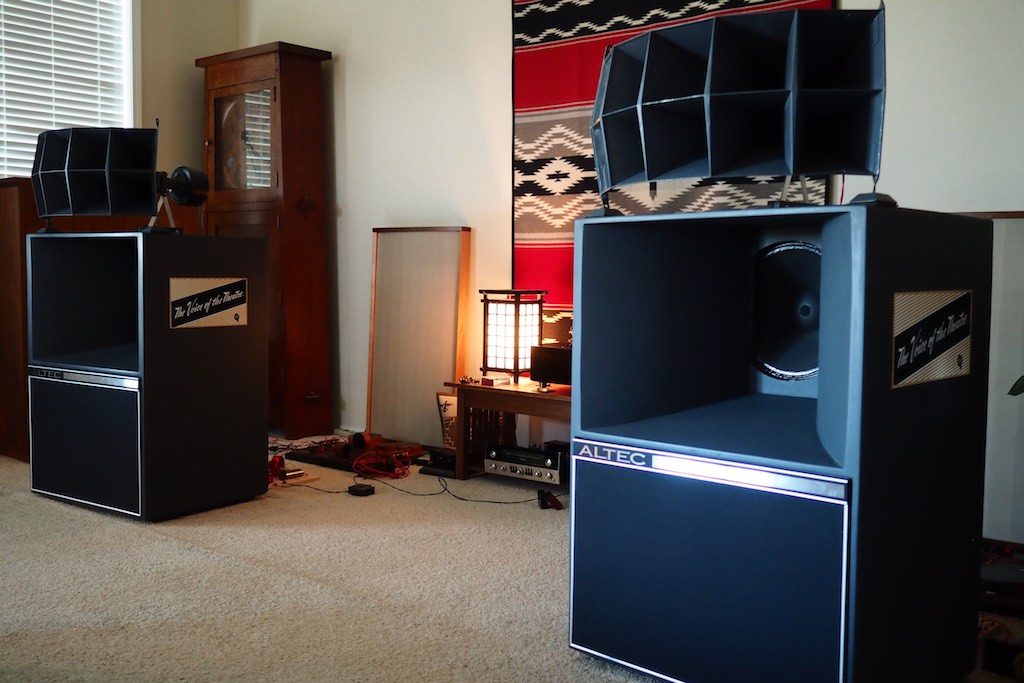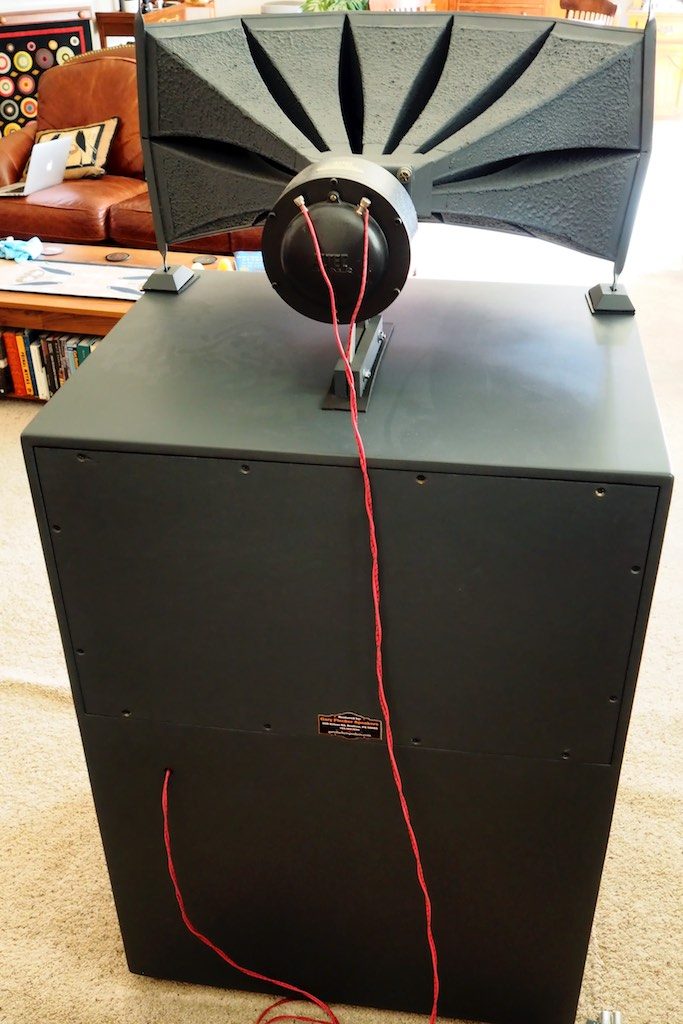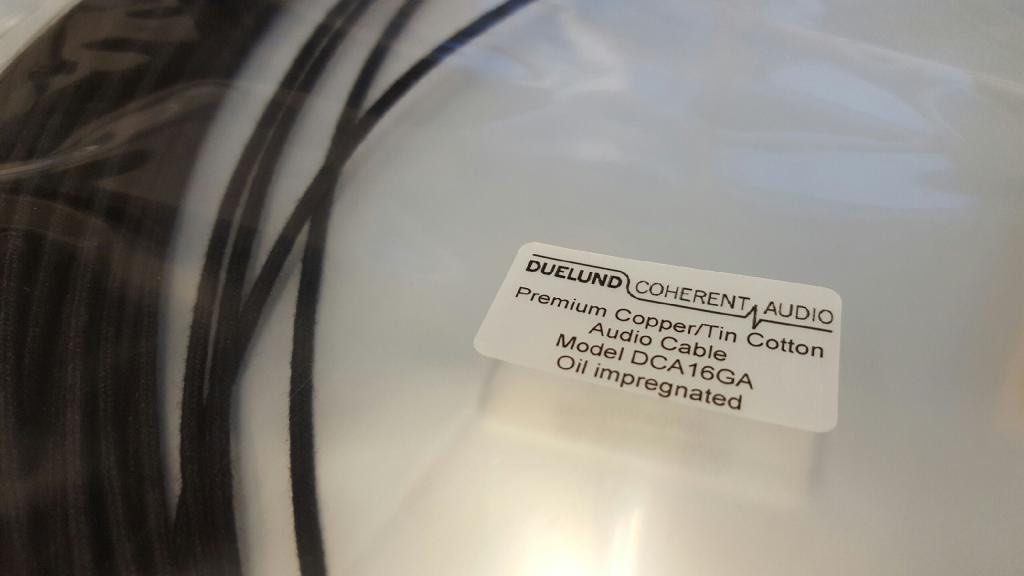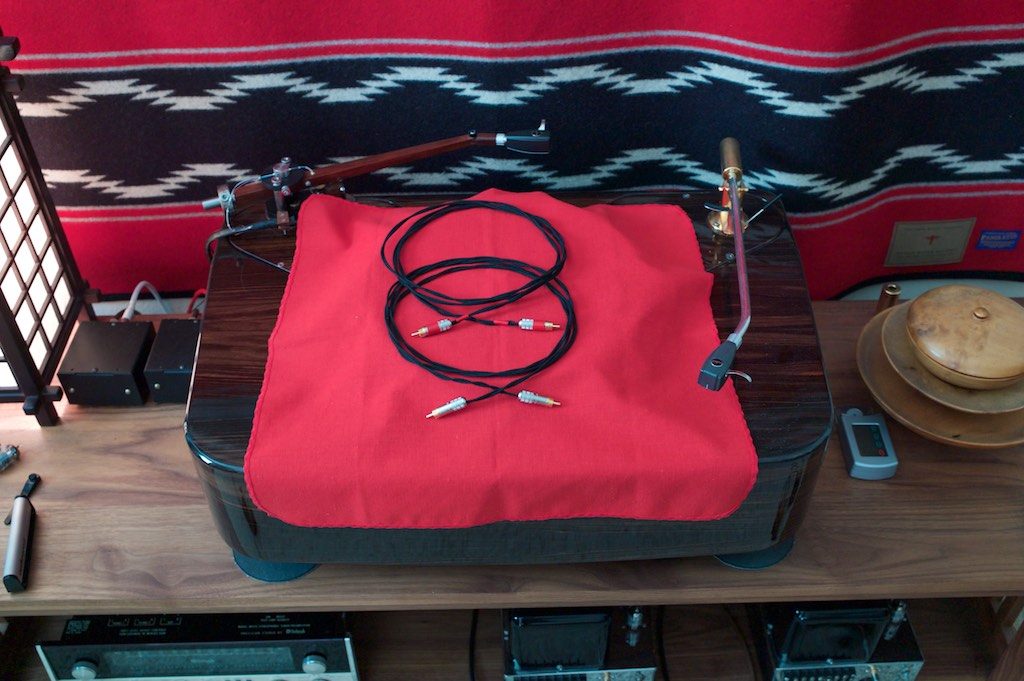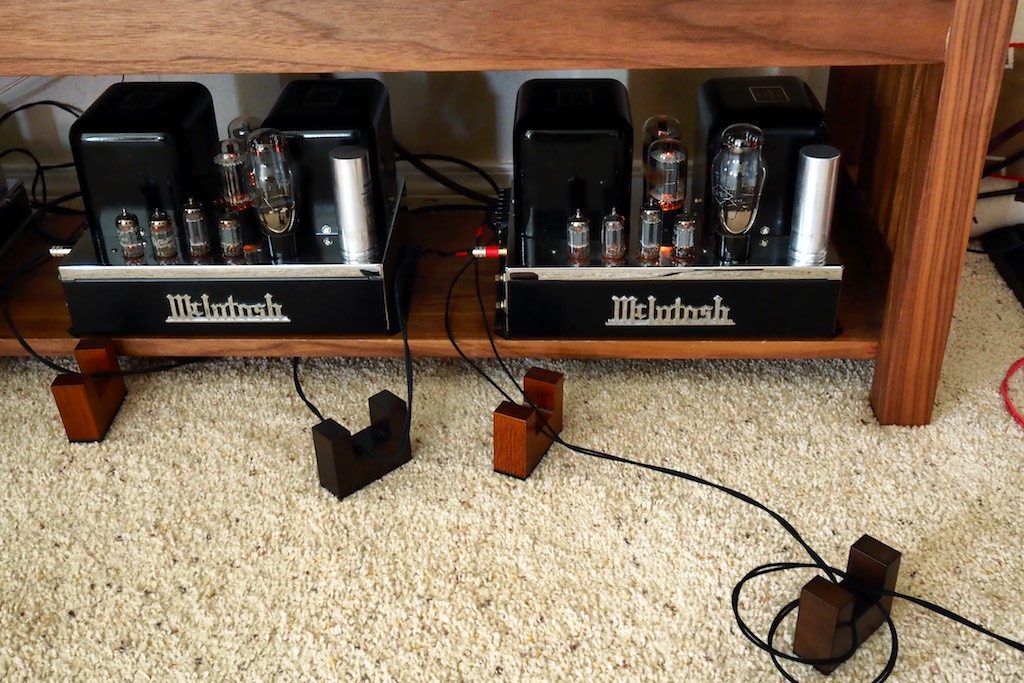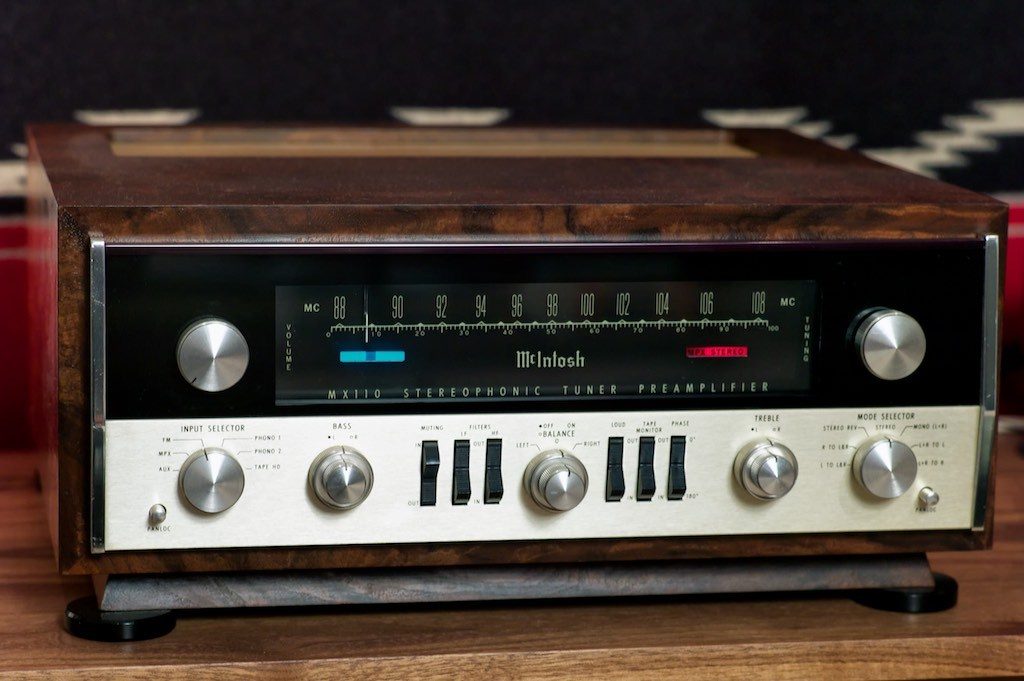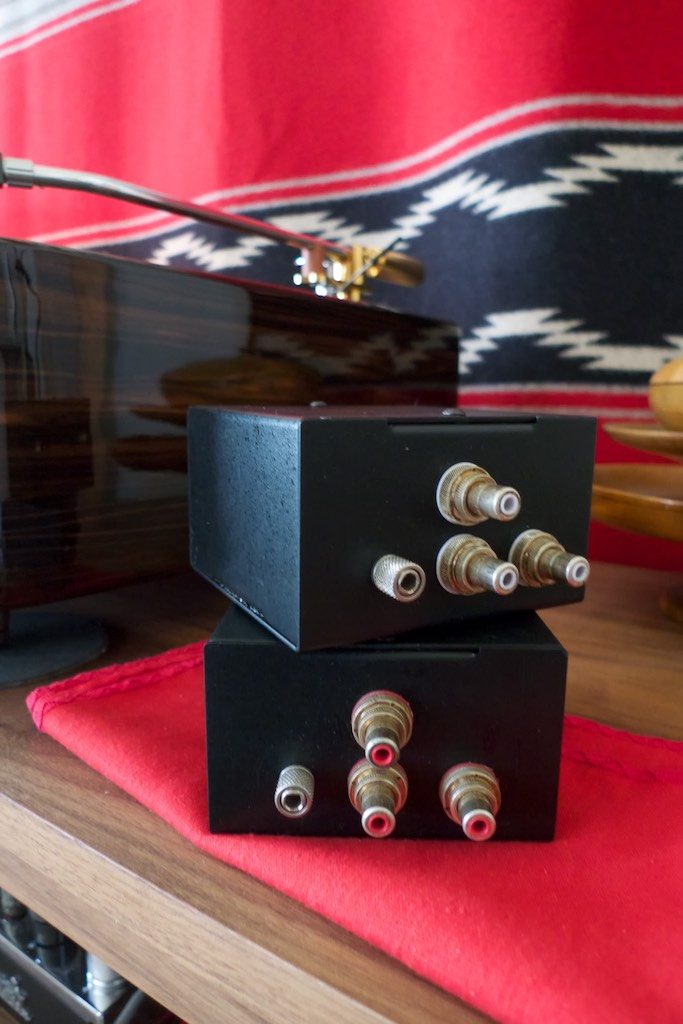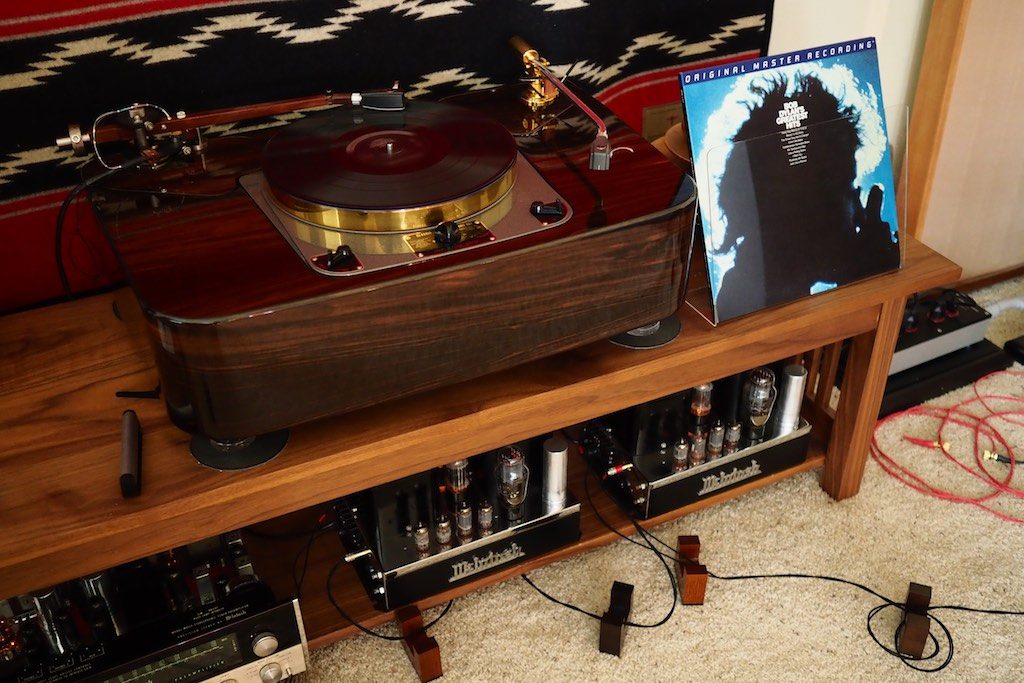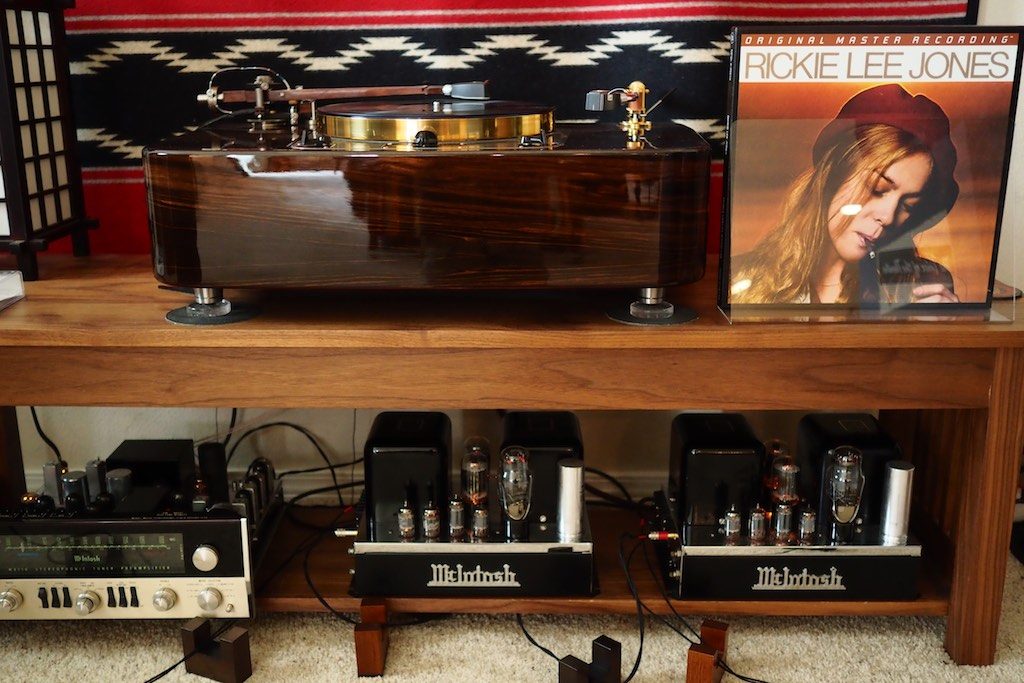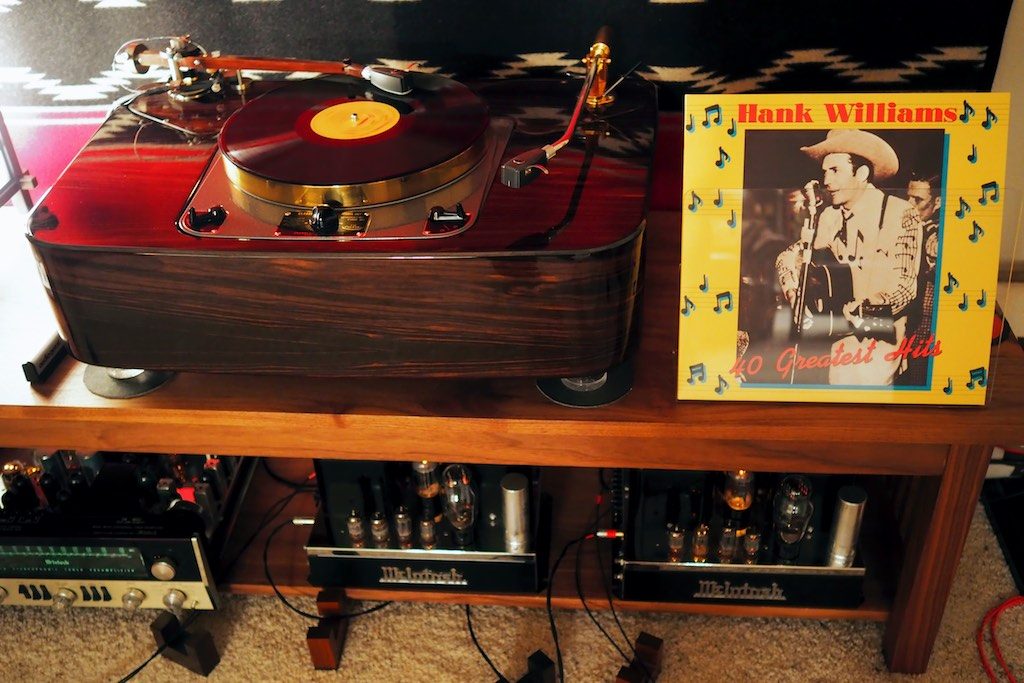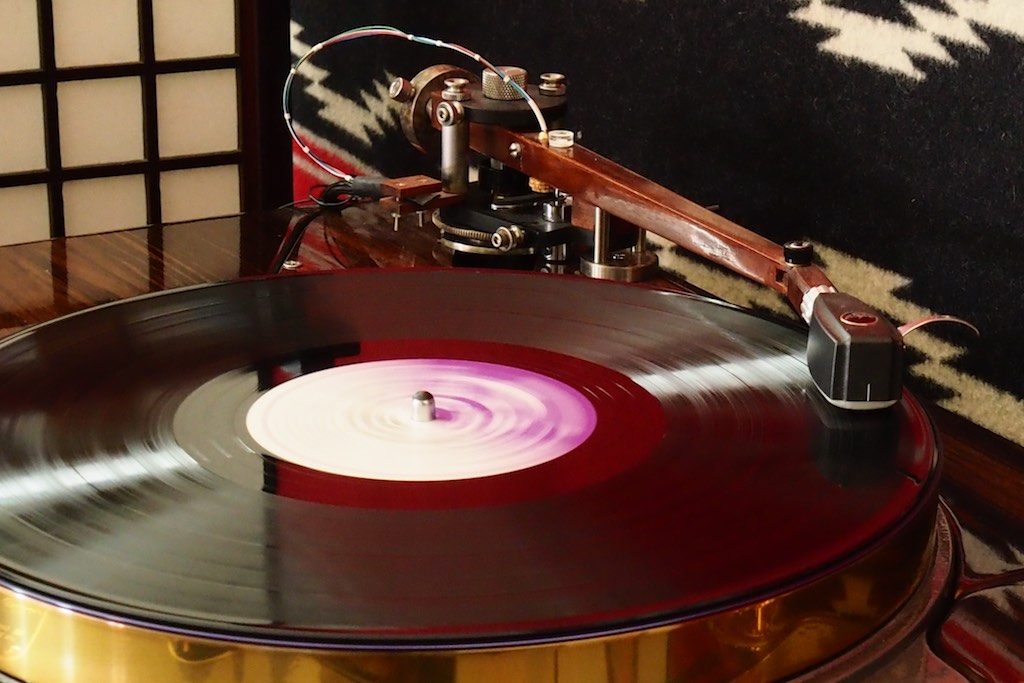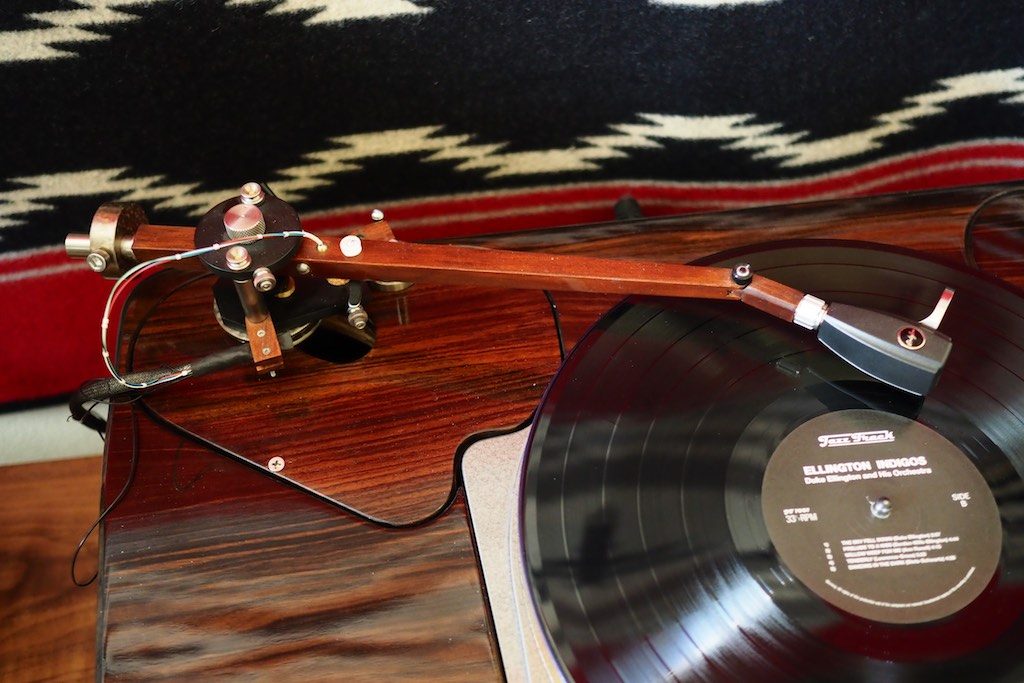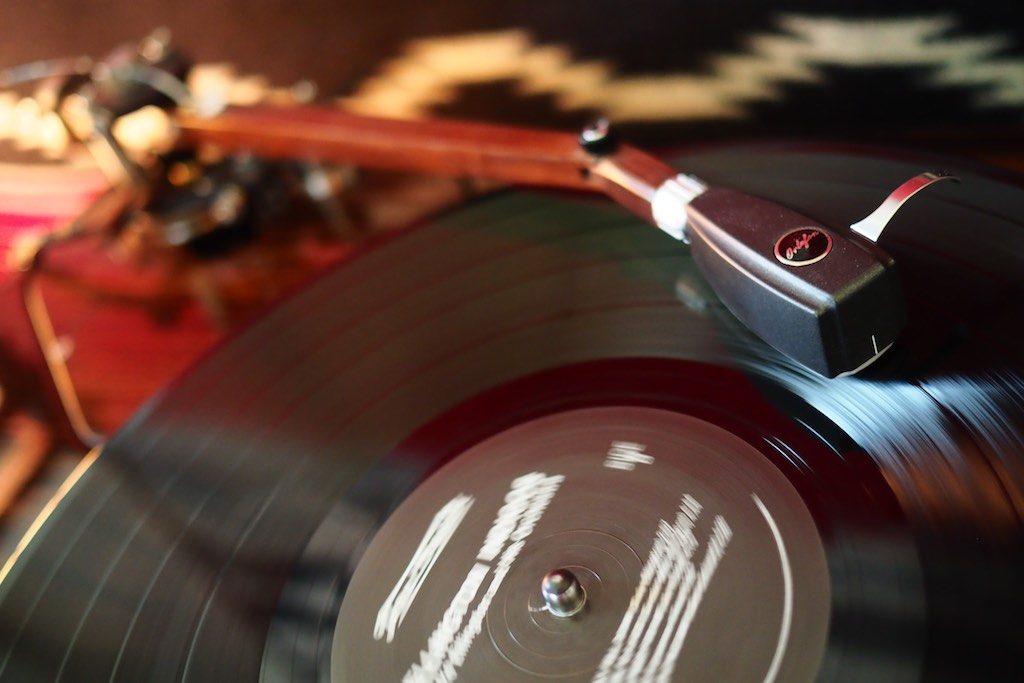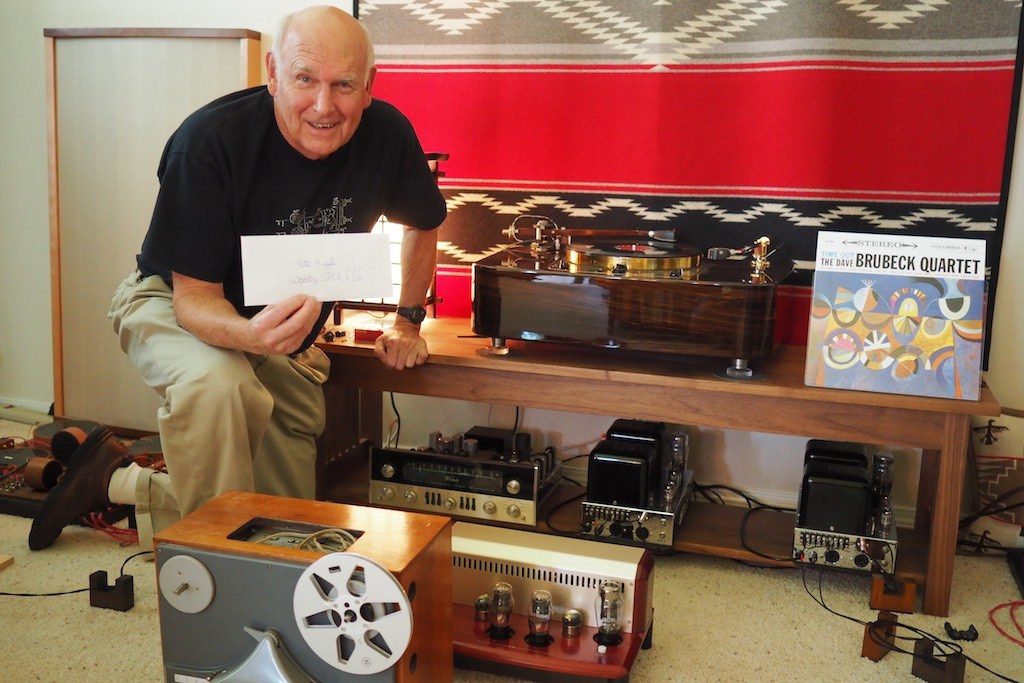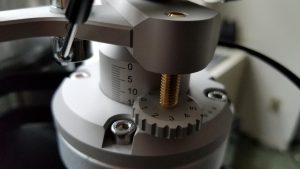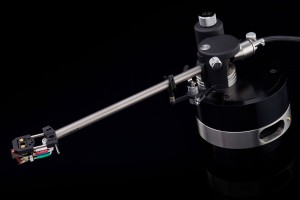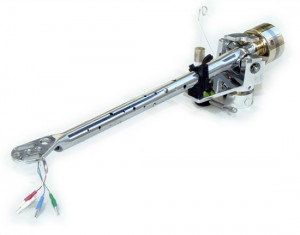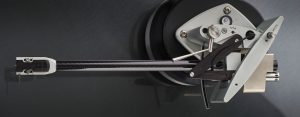The 12.5-Inch Woody SPU Tonearm™ from Pete Riggle Audio Engineering.
If Gustav Stickley (1853 – 1942), the renowned figure of the Arts & Crafts movement in America, were to have made a tonearm to complement his American Craftsman style of furniture, what would it have looked like?
I like to imagine that if Stickley had made a tonearm it would have looked a lot like the 12.5-inch Woody SPU Tonearm™ from Pete Riggle Audio Engineering.
I really love the Stickley design aesthetic, and I treasure the way too few examples of Stickley furniture that I have in my home. I so admire the Stickley values of beauty, simplicity, and quality in product, which are production values that seem so rare today in popular consumer culture.
Stickley wood finish that emphasizes the beautiful grain of the wood.
The Stickley aesthetic of woods stained to emphasize the natural beauty of their grain, the hammered & patinated metal hardware, and an exposed architecture that emphasized the quality of their design, were hallmarks of the Stickley design aesthetic.
Hammered bronze clock face of my Stickley Asheville clock.
Stickley's trademark is a joiner's compass with the Flemish phrase Als Ik Kan written inside it, which translates to the best of my ability, and as you will read during the rest of this article, Als Ik Kan also applies to the 12.5-inch Woody SPU Tonearm™ from Pete Riggle Audio Engineering.
The 12.5-inch Woody SPU Tonearm™ has a French polish finish like a fine custom guitar.
Each 12.5-inch Woody SPU Tonearm™ is hand-crafted by Pete Riggle in what is essentially a labor of love, from the hand-rubbed French polish finish over an aged Spanish Cedar wood tonearm wand, to the lacquered brass finish of the brass parts (or optionally, a 'Smokey Silver' finish).
Hammered metal patina on the Counterweight for the Common Man.
The 12.5-inch Woody SPU Tonearm™ has quite a number of interesting features, like those that allow for adjustability while playing a record; including adjustment of the vertical tracking angle (the relative angle of the stylus to the record groove), adjustment of the azimuth (the left or right tilt of the cartridge body), and adjustment of the anti-skate bias (the tonearm force that pulls the cartridge towards the center of the record); or those design features like the string unipivot bearing system, an integral snubber, the ability to use oil damping if desired, the sliding arm-mounting plate that allows sufficient range of adjustment for correct overhang with either an A or G-style SPU cartridge, and a unique articulated joint inspired by the vintage Garrard Model TPA-10 12-inch transcription tonearm.
I'd like to share a little story with you about the time that Rafe Arnott and Don Parkhurst did a road trip from beautiful British Columbia to my place in Washington State for a listening adventure.
The idea was for Rafe & Don to hear my big Tannoy Westminster Royal Special Edition loudspeakers, with their very special Duelund CAST external crossovers, so they could write a 'road trip' article about their adventure for Part Time Audiophile, which you can read here.
Rafe getting an action shot of the 12.5-inch Woody SPU Tonearm™ during his visit to Jeff's Place.
At the time of Rafe & Don's visit I had been experimenting with comparing my 12-inch Thomas Schick tonearms to the 12.5-inch Woody SPU Tonearm™ on my Garrard Project 2015 turntable (Issue 79).
Leo, Ron, and Pete were all in attendance for Rafe & Don's visit, and we were all having a grand time listening to music, talking about audio, and enjoying some really nice regional wines & craft beers, while we did a musical time-travel journey through the recording arts, starting with early mono recordings, and then working our way through time to the 'modern' stereo era.
I had been playing my Thomas Schick 12-inch tonearm fitted with an Ortofon SPU Classic GM MKII stereo cartridge for my visitors, and the results were superb.
The 12.5-inch Woody SPU Tonearm™ on the Garrard Project 2015 Player System.
During our listening session, I swapped out my 12-inch Thomas Schick tonearm that I use for stereo cartridges for the 12.5-inch Woody SPU Tonearm™ so the group could do a little impromptu 'audio reviewing' session, and so I could hear their impressions about the differences they heard between these two very different tonearms, to augment my own.
After getting everything swapped, adjusted, and ready to play music, I queued up the record we had just listened to, and then played it using the 12.5-inch Woody SPU Tonearm™ mounted with my Ortofon SPU Classic GM MKII stereo cartridge.
I figured it would be one of those "the Schick tonearm sounds like this," "the Woody SPU Tonearm™ sounds like that," "I like this one better, no, I like that one better," sort of comparison, where we could all weigh in and discuss the relative musical & sonic merits we heard from these two very different approaches to tonearm design.
The 12.5-inch Woody SPU Tonearm™ on the Garrard Project 2015, top view.
When the stylus of my Ortofon SPU Classic GM MKII stereo cartridge touched down in the groove and began to play music the result was dramatic, with the Woody SPU Tonearm™ slapping down my Thomas Schick tonearm so severely that everyone in the room was shocked.
The noisy room full of happy chatting music lovers went dead quiet as we listened to the result of the dramatic transformation brought about by the 12.5-inch Woody SPU Tonearm™ on my Garrard Project 2015 turntable. I knew the 12.5-inch Woody SPU Tonearm™ was very good, but until this moment I had not completely realized how tremendously good this tonearm really was.
The 12.5-inch Woody SPU Tonearm™ with the Ortofon SPU Classic GM MKII stereo cartridge.
The 12.5-inch Woody SPU Tonearm™ sounded ridiculously good compared to my highly regarded Schick tonearms, it wasn't even close!
In comparison to the Schick, the 12.5-inch Woody SPU Tonearm™ had much more room-filling presence, with a much greater sense of space, and a rich, natural, organic, and liquid presentation that was very easy to enjoy, and it portrayed female vocals more realistically & naturally. The 12.5-inch Woody SPU Tonearm™ was also more convincing from a timbral and tone color perspective, having much more of a 'real sound' presentation of timbral textures and tone color distinctions.
Pete Riggle Audio Engineering
Pete is an engineer with a passion for music, and he has worked in the high-tech world of government engineering projects all his life. Engineer by day, and music lover by night, Pete pursued enthusiast audio in parallel with his professional engineering career, and over time has built just about every type of audio component you can imagine from scratch, just for the fun of it.
Pete Riggle at Jeff's Place during Rafe & Don's visit.
These days Pete is retired and focuses his energy on family, friends, and his passion for audio.
Pete hangs a shingle out in the audio realm in the form of Pete Riggle Audio Engineering, where he offers his popular Vertical Tracking Angle on the Fly (VTAF) device for a variety of tonearms (Ortofon recommends it to their customers with Rega arms), several models of his Woody tonearms, hand-selected 'by ear' crossover capacitors, as well as other audio goodies.
Pete's collection of classic & custom loudspeakers that he keeps in his 'Garden of Earthly Delights' listening room all play music extremely well and sound extraordinarily good.
Recently I had the opportunity to visit Pete's 'Garden of Earthly Delights' and hear Pete's Altec A7 Voice of the Theatre loudspeakers with the custom crossovers he built, which are based on the Hiraga A5 crossover design, but with clever mods, and tasteful choices of components, to optimize them for the Altec A7.
I was shocked at how good Pete's Altec A7's played music and sounded. They sounded so good that I asked Pete to advise me on my own crossovers for my vintage Altec A5 & A7 loudspeaker projects, which I will be telling you all about in upcoming articles here at Positive Feedback.
I asked Pete if he would share a bit of his musical & audio journey with us, and here's what he told me:
"In the early nineteen-forties we had a big Philco console radio in the living room of my grandparent's home, into which I was born. The radio belonged to my mother. It had vacuum tubes and a big round paper coned speaker. We liked to listen to KGO in San Francisco, and stations in Denver and Spokane, which we could get at night. Radio was a big deal then. My sister and I would sneak out of bed and sit out of sight on a landing at the top of the stairs listening to Amos and Andy, The Shadow, Mr. and Mrs. North, and The Life of Riley."
"In the fall of 1957 my young wife and I bought a small Magnavox record player with four Danish Modern legs and a medium-sized lightly built outboard speaker enclosure with a 12-inch permanent magnet speaker. The record changer was a Collaro. It was my second year of engineering school."
"I was beginning to understand the physics of sound reproduction, and mail order catalogs full of audio components occupied my attention. In those days the more frugal audiophiles bought separate loudspeaker drivers and built their own speaker cabinets. My first DIY project was adding an inexpensive paper coned tweeter, with an L-pad, to the speaker in the Magnavox enclosure. I thought it sounded better. Those catalogs full of speaker parts, resistors, wire, capacitors, and chokes carried with them an inescapable mystique, which remains vivid to me to this day."
"In the very early nineteen sixties my days were spent in engineering classes at the University of Washington. Evenings were spent on second shift as an engineering aid at the Boeing wind tunnel complex testing the aerodynamic characteristics of models of the Minuteman missile, the Boeing supersonic transport (never built), and Boeing's version of the F111 aircraft."
"During this period of university days and wind tunnel nights, an Eico HF81 push-pull stereo integrated amplifier kit came on the scene. The amplifier used the ubiquitous 12AX7 and EL84/6BQ5 tubes. It had a volume control, tone controls, a balance control, a phono stage, and a selector switch. Even today I insist upon a balance control of one sort or another. The Eico HF81 is now considered a treasure. I sold mine in the early sixties. Rats. In those days second shift at the wind tunnel was 4:00 pm until 12:30 am, and for quite a few nights between the hours of 1:00 am and 2:00 am were spent building that amplifier kit."
University of Washington.
"In the early sixties there was a guy in Seattle selling unbranded 8-inch Japanese full- range paper-coned drivers along with plans for sealed enclosures. He called it the "Black Box". He actually had a tiny store front in a less affluent part of downtown Seattle. Being a poor university student, this appealed to me, so I bought the speakers and instructions. I don't remember cutting out the boxes for my speakers, but somehow I did it and got the boxes assembled and finished in flat black with orange burlap grill cloths. There were what seemed like a million screws for the removable back panel of each speaker. It was a death march to remove and reinstall the back panels. This was before we figured out that we could drive screws in and out with a drill-motor. My turntable/tonearm combo at the time was a Bogen B61 (a rebranded Lenco), with idler drive. The cartridge might have been a Shure, but it is past remembrance."
"In 1962, within months of receiving an engineering degree from the University of Washington, I purchased driver components for a stereo pair of University Classic Mark II loudspeakers. These had a very impressively constructed (think Altec) 15-inch woofer, a nicely constructed 8-inch midrange driver, and a linen reinforced phenolic dome tweeter. The crossover points were 300 and something like 3000 Hz. I assembled these into a very heavy home-built version of the prescribed cabinets, with home-built crossover networks, using DIY hand wound chokes."
"By the mid-sixties I was building a second order three-way electronic crossover with selectable crossover points. This was a discrete transistor device. The construction article and schematic were provided by G.C. McProud of Audio magazine."
"Around 1978 I developed 4-way, five cubic foot, sealed column loudspeaker product. It was inefficient, but was theoretically 3 dB down at 20 Hz. For research purposes I developed a four-way electronic crossover, using op-amps, and added a Hafler DH200 stereo transistor power amp to the three Dynaco Stereo 120 amps. The crossover had selectable crossover points, allowing speakers to be sorted through to find the best drivers for each of the frequency ranges. I began manufacturing these 100-pound loudspeakers and found myself losing money on every pair. It didn't help trying to make it up in volume. Even at that time there were at least 400 easily identifiable companies manufacturing loudspeakers. This was a great learning experience. My company name at that point was Riggle Acoustics. Following the advice of a wise uncle I shut the company down out of common sense. My disappointment was such that I took up fly-fishing instead of manufacturing loudspeakers, and which remains a wonderful diversion to this day."
"I attended the 2001 & 2003 Vacuum State of the Art Conferences (VSAC) brought to us by Dan Schmalle (aka Doc Bottlehead), and was enthralled by the peoples' audio on display, which reinvigorated my interest in home audio."
"My response was to build a large shop building (36 x 50 feet) on our property for audio adventures, one third of which has become a listening room, which I refer to as the 'Garden of Earthly Delights'."
Pete's 'Garden of Earthly Delights'.
"In the loft of the listening room I built in a 29-foot long exponential horn designed with a flare frequency of 15Hz. This horn plays 3dB down at 20Hz. The mouth is 9.5 feet wide by 6 feet high. I designed this horn with advice from the intrepid Steve Schell (see the Lansing Heritage web site). I made cutting diagrams for all of the panels, and built a scale model from the cutting diagrams. The miracle of this horn is that a growing group of friends gathered with me for what might be called a 'horn raising' party. We started cutting wood at 10 a.m., broke for lunch at 2 p.m., and had the horn assembled and playing before dinner by 8 p.m. The next day I crawled inside the horn looking for daylight at the joints, ran a little caulk, added a little external bracing, and now have been playing the horn for about 10 years. It works well with any pair of loudspeakers one harnesses it with. Surprisingly, it always seems to work best played up to a cut-off frequency of 160Hz. Go figure."
"Around 2003 I was re-introducing myself to vinyl playback. After a dozen year hiatus, it was frightening to mount a cartridge or cue up a record. I got over that in a hurry. The turntable was a Thorens TD125 with a Rega RB250 tonearm rewired by Origin Live, and with an Origin Live counterweight. It was a relief to get back to the sonic pleasures of analog. I wanted to explore the effects of VTA (more specifically the related stylus rake angle), and as anyone who has tried to set VTA with this type of setup will tell you, it is a nightmare."
VTAF shown at the bottom of the 12.5-inch Woody SPU Tonearm™.
"I spent over a year unsuccessfully looking for an after-market device that would easily allow the user to adjust VTA. I just couldn't find one. So I got busy designing one for myself, specifically for Rega post mounted arms. I developed a device I call the VTAF, pronounced "vee-taff," which stands for Vertical Tracking Angle On The Fly."
"My life changed when I did the first needle drop with the VTAF. Within a note or two my chin dropped. I could hardly believe my ears. Even before experimenting with VTA the sound was dramatically more musical, with improved sound stage, imaging, inner detail, air, nuance, dynamics, and bass tonality, and with no clinical effect. At that point I realized that I was obliged to bring the VTAF to market. I patented the device and began production. A simple market analysis suggested that there were so many Rega arms on the market that one could stay busy just making VTAF units for Rega arms. That turned out to be overly optimistic. But many people inquired about fitting the VTAF to other brands and models of tonearms. With every inquiry I did the work and added an arm to the list of arms that can be improved by the VTAF. Now there is a VTAF for almost any tonearm. The VTAF has received hundreds of strongly favorable customer testimonials."
"The VTAF is unique in that the tonearm floats under the influence of gravity in a bronze bushing fit into the armboard mounting hole. The bushing accurately positions the tonearm with very little error, but does not tie the tonearm-bearing pedestal down. This floating connection absorbs vibrations, preventing tonearm vibrations from entering the armboard, resonating in the armboard, and returning back down the arm wand as delayed and distorted signals that would blur the sound."
Counterweight for the Common Man shown on the 12.5-inch Woody SPU Tonearm™.
"Along the way I added the Counterweight for the Common Man (CCM) to my stable of products. The CCM is a high performance and cost effective replacement for Rega counterweight systems, and improves any Rega tonearm."
"For years I was fascinated with tonearms and interested in the possibility of manufacturing them; however, the technology was a little intimidating. But one gets older and wiser, has a bigger bag of skills, and the Internet helps."
"Using the very successful VTAF as a mounting system, I engineered and developed a tonearm system using a wood wand, a novel close-coupled string bearing, and oil damping. The idea was to use wood & brass wherever practical. I substituted Delrin™, a machinable plastic, in places where wood was impractical. I called this product the Woody Universal Tonearm™. While developing the Woody Universal Tonearm™ I had in mind a system that could be manufactured in a small shop under the watchful eye of a single artisan craftsman (me) using materials with desirable acoustic properties."
Woody cross-section diagram.
"I kept a long list of the features that I wanted in a tonearm, with the result being the Woody Universal Tonearm™".
The subject of this article, the 12.5-inch Woody SPU Tonearm™, $2000 USD.
In this article I want to focus on Pete's 12.5-inch Woody SPU Tonearm™, which is his latest, and I think his greatest, achievement to date.
The 12.5-inch Woody SPU Tonearm™.
Pete had earlier volunteered to let me listen to his Woody Universal Tonearm™ on my Garrard Project 2015 player system, but I had declined as I had been focused on my Ortofon SPU phono cartridges, and the Woody Universal Tonearm™ was not compatible with the SPU-style of cartridges (or the SME-style headshells). The Woody Universal Tonearm™ also required a significantly different style of mounting to the armboard than my Schick tonearms, and I didn't want to alter the expensive custom Artisan Fidelity armboards that were veneer-matched to my Artisan Fidelity plinth.
Pete came by for a visit one afternoon, and he was quite taken with the performance of my Ortofon SPU Mono CG 25 Di MkII phono cartridge while we were listening to the Masterpiece's by Ellington mono LP that I had playing.
Pete's intrigue with the SPU's performance led him home to his workshop, where he began to consider how he might modify his Woody Universal Tonearm™ design so that it would be compatible with both SPU cartridges and the SME style of headshells.
As Pete told me, "The problem, though, was the question of how to make the bend of the tonearm wand required by the SPU cartridges with their integrated headshell, and the SME-type headshell electrical connection. With aluminum arm wands this is usually done with a bend of the arm wand tube, but that's not possible with a wood arm wand. My prayer was answered when I found an image of a vintage Garrard tonearm, the Model TPA 10, 12-inch Transcription Tonearm. This Garrard arm included an articulated joint near the headshell. This Garrard arm also had a telescoping wand, to allow the user to adjust overhang. With these features, the Garrard arm could use an integrated headshell and still achieve alignment and adjust overhang."
"I did some careful design work and found out that with the Woody Universal Tonearm™ it was possible to fit an articulated wood end joint long enough to accept a standard SME type universal headshell connector, with the attractive wood end-joint blending into the rectangular cross section of the wood arm wand, and to bore the end-joint to accept a brass tube which would then accept the standard SME type headshell connector, with a spring fit connection to allow the headshell to be rotated for azimuth adjustment."
Top view of the articulated armwand joint of the 12.5-inch Woody SPU Tonearm™.
"Rather than attempt a telescoping arm wand to adjust overhang, as had been done with the Garrard TPA 10, it made more sense to use a sliding mounting plate, similar in concept to the SME sliding mounting plate, but much simpler to execute, and hidden from sight by the VTAF adjuster wheel. I already had the VTAF style of sliding mounting plate as a product."
"The SME SPU tonearm has an effective length of 12.2 inches. Unlike arms by Ortofon, Thomas Schick, and many other similar bent and S shaped arms, The 12.5-inch Woody SPU Tonearm™ has the sliding mounting plate to allow adjustment of overhang relative to the spindle to pivot distance, and has the articulated end joint to allow accurate alignment."
"So the 12.5-inch Woody SPU Tonearm™ allows correct overhang adjustment and correct alignment when using an Ortofon SPU cartridge. This doesn't sound revolutionary at all, but arms like those by Ortofon and Thomas Schick have no provision whatever for alignment or for overhang adjustment."
"Perhaps the combined use of a wood arm wand with string bearing, oil damping, VTA on the fly, Azimuth on the fly, and anti-skate on the fly, in conjunction with an Ortofon SPU cartridge is revolutionary in the 12.5-inch Woody SPU Tonearm™."
Sliding mounting plate in the slot on the armboard for the 12.5-inch Woody SPU Tonearm™.
"One more aspect of the 12.5-inch Woody SPU Tonearm™ arm is that the sliding mounting plate provided with the arm allows sufficient adjustment that the user can use either the A or G style SPU cartridges with the same arm."
Installation & Setup of the Woody SPU Tonearm™
When you first open the shipping box containing your new 12.5-inch Woody SPU Tonearm™, you'll want to take out the owner's manual and read through the introductory sections to get the lay of the land, and then you'll want to get busy familiarizing yourself with the shipping package's contents for installation & setup.
Shipping box containing 12.5-inch Woody SPU Tonearm™.
Unlike most tonearm manuals, the 12.5-inch Woody SPU Tonearm™ owner's manual contains a wealth of information, reflecting Pete's engineering background in its attention to detail, as well as lots of practical advice that should make it possible for anyone to follow the installation & setup instructions to successfully get a 12.5-inch Woody SPU Tonearm™ up and running. If you get confused on what to do, Pete's only an email or phone call away.
The 12.5-inch Woody SPU Tonearm™.
The 12.5-inch Woody SPU Tonearm™ is very adjustable, and that can be a little bit intimidating at first during the initial mounting & setup, but fortunately, Pete's very detailed owner's manual gives step-by-step instructions to get everything up and running in a straightforward fashion, and after that it'll be clear sailing for getting the best out of your record collection.
Mounting template.
You'll need to prepare your armboard for installation of the sliding mounting plate & mounting bushing that the 12.5-inch Woody SPU Tonearm™ inserts into, for which Pete provides a mounting template for the dimensions & orientation, as well as detailed instructions, so you can cut the armboard slot in just the right place for your turntable. You can see the mounting template sitting on my turntable next to the armboard as an example, in the photo above.
Artisan Fidelity can't take credit for the beautiful armboard the 12.5-inch Woody SPU Tonearm™ is mounted on in the accompanying photos. For this review, Pete created a beautifully hand-crafted armboard for me to mount the 12.5-inch Woody SPU Tonearm™ on that was a drop-in & drop-dead gorgeous replacement for my custom Artisan Fidelity armboard. I am very impressed.
Pete's armboard matched my Artisan Fidelity plinth perfectly!
You can see the slot for the sliding mounting plate in the armboard photos, which makes adjustment of correct overhang relative to the spindle-to-pivot distance a breeze when experimenting with A or G style SPU phono cartridges. It's really nice to have this adjustment, as with my Schick tonearms, for example, you have to have multiple tonearms in order to accommodate the differing length of the A or G style SPU cartridges. Being able to have one tonearm that can accommodate both A or G style SPU phono cartridges with a simple adjustment is both convenient and cost effective, and as a bonus, Pete provides an additional template to get both A or G style SPU phono cartridges setup perfectly.
Template for A or G style SPU phono cartridges.
After the 12.5-inch Woody SPU Tonearm™ is mounted to the armboard, the guide assembly is installed, then it's time to mount your chosen phono cartridge to the armwand. One of the beautiful things about the standard SME type universal headshell connector that is used in the 12.5-inch Woody SPU Tonearm™ armwand is that it makes it so easy to install either SPU phono cartridges, or a conventional cartridge mounted on a headshell, and swap them in and out as you see fit.
The SME type universal headshell connector on the Woody armwand.
I really like having two tonearms on my Garrard Project player system, with one tonearm setup for my Ortofon SPU Classic GM MkII stereo phono cartridge, and one tonearm setup for my Ortofon SPU CG 25 Di MkII mono cartridge.
Ortofon SPU Classic GM MKII on the Schick tonearm.
It is incredibly convenient to have two tonearms setup & optimized for the stereo & mono records I enjoy listening to so that I can swap what record I want to listen to on the fly without having to do any tonearm setup work.
Ortofon SPU Mono CG 25 Di MKII on Schick tonearm.
I also variously enjoy using my Denon DL103 & EMT TSD-15N stereo phono cartridges, mounted on the impressive Thomas Schick headshell, when duty calls, and from Yazaki-san's inspiration, a vintage Shure V15 III with a VN35MR stylus mounted on a Yamamoto HS-1A African black wood headshell, fitted with Western Electric WE24GA headshell wires.
Denon DL-103 & Schick headshell.
EMT TSD-15 & Schick headshell.
Vintage Shure V15 III with a VN35MR stylus.
Each of those phono cartridges have their own special charms, and I wouldn't want to be without any of them!
Once you pick out a phono cartridge to start your setup with, then you can go through the rest of Pete's setup regimen of installing the appropriate counterweight for your cartridge's mass, setting the tracking force, setting the overhang, dressing the wire harness compliance loop, doing a course adjustment of VTA, doing a course adjustment of azimuth, check cartridge alignment (as needed when using a headshell), adjust lateral balance, adjust anti-skate, adjust the lift/lower mechanism, fill the damping cup with the desired amount of damping oil, connect the 12.5-inch Woody SPU Tonearm™ to your phono stage, and play a record!
Once you're done setting up the feature-laden 12.5-inch Woody SPU Tonearm™ you're good-to-go until you want to mount a different phono cartridge. Mounting a different SPU phono cartridge, or a cartridge attached to a headshell, is an easy transition, a 'plug & play' experience with only the tracking force & azimuth (I use a small mirror) needing adjustment between swaps. It's a quick & a snap!
Living & Listening with the Woody SPU Tonearm™
Well I hope I've given you a feel for the 12.5-inch Woody SPU Tonearm™, and as you probably gleaned from my introduction and the mention of Rafe & Don's visit, the 12.5-inch Woody SPU Tonearm™ is a formidable performer both musically & sonically, and it mercilessly slapped down my highly respected and Stereophile 'Class A' $$$ rated Thomas Schick tonearms in rather startling fashion.
Schick tonearm on the GP2015.
As Rafe said in his article for Part Time Audiophile about the 12.5-inch Woody SPU Tonearm™ with my Tannoy Westminster Royal SE loudspeakers, "The sound was downright spooky at times, with Dizzy Gillespie, Freddie Hubbard and Clark Terry looming over me as they belted out The Alternate Blues "Alternate One" off the same test pressing (never to be named) with so much raw power that I kept looking over, and making crazy faces at Jeff because the imaging, timbre, attack, and decay on notes was having such a visceral impact on my listening experience that I felt the need for reassurance from him that I was indeed hearing what I thought I was (for the record, every time I looked over at him, Jeff looked right back, and nodded very seriously, so I knew I wasn't just loaded or crazy, or both). The room was suffused, awash, almost drowning in sonic emotional heft as the notes broke free from the final vestige of their electronic confines, and exploded into the darkened space around us."
The gulf in performance between my Thomas Schick tonearms and the 12.5-inch Woody SPU Tonearm™ playing my Ortofon SPU Classic GM MkII stereo phono cartridge was so huge that I was rather incredulous, and it left me wondering what was going on with this highly atypical tonearm that could explain that.
The Woody SPU Tonearm on the GP2015.
As such, the 12.5-inch Woody SPU Tonearm™ has gone through a much longer evaluation & review period than is my norm, and I've spent over a year living & listening with it in multiple system setups, trying to understand its mysteries. I want to thank Pete Riggle for being so patient with me during this very long review period.
A Woody-Wire Re-Wire of the Thomas Schick Tonearm
As I was seeking to understand the rather remarkable performance of the 12.5-inch Woody SPU Tonearm™ on my Garrard Project 2015 player system, I wondered if a fair amount of the difference could be attributed to the different tonearm wire used in the 12.5-inch Woody SPU Tonearm™ versus the 12-inch Thomas Schick tonearm, so I asked Pete to indulge me, and to wire one of my Thomas Schick tonearms with the same wiring complement used in the 12.5-inch Woody SPU Tonearm™, from the tip of its SME type universal headshell connector to its internal connections, and from its internal connections all the way to its RCA cable terminations, to see if that would help explain the huge performance difference.
Schick tonearm rewired with 'Woody Wire'.
To cut to the chase, the complete rewire of the Schick with the same wiring used in the 12.5-inch Woody SPU Tonearm™ didn't make them sound alike, nope, not even close.
In fact, to my surprise, the sound of my Thomas Schick tonearm really didn't change significantly, suggesting that either Pete's & Thomas' tonearm wires are roughly equivalent in their performance, or alternatively, the Schick tonearm is relatively wire-insensitive.
So that likely means the rather dramatic sonic & musical performance prowess of the 12.5-inch Woody SPU Tonearm™ when playing records with my Ortofon SPU Classic GM MkII stereo cartridge is due to its inherent design, choice of natural materials, and high level of adjustability to optimize its performance.
The musical & sonic superiority of the 12.5-inch Woody SPU Tonearm™ was maintained across my stable of stereo phono cartridges: The Ortofon SPU Classic GM MkII, the Denon DL103, the EMT TSD-15N, and my vintage Shure V15 III with a NOS VN35MR stylus.
For reasons I still don't understand, the same was not true for my Ortofon SPU CG 25 Di MkII mono cartridge, which sounded about the same mounted on my Thomas Schick tonearm as it did on the 12.5-inch Woody SPU Tonearm™. In fact, I think the Schick tonearm sounded a little better than the 12.5-inch Woody SPU Tonearm™ in sonic & musical performance when playing mono records with my Ortofon SPU CG 25 Di MkII mono cartridge, but not by much.
Schick with Ortofon mono cartridge on the GP2015.
Since I use two tonearms on my Garrard Project 2015 player system, I'm using the 12.5-inch Woody SPU Tonearm™ for all my stereo phono cartridges, and my 12-inch Thomas Schick tonearm for my Ortofon SPU CG 25 Di MkII mono cartridge, in a classic display of a win-win!
As you can imagine, over the course of the last year or so I've listened to countless records with the 12.5-inch Woody SPU Tonearm™, and I always came impressed with its musical & sonic prowess.
I won't drone on about record after record, but let me describe a couple of listening examples with the 12.5-inch Woody SPU Tonearm™ using my restored vintage Altec A5 Voice of the Theatre loudspeakers, for which I'm fine tuning my breadboard crossovers right now, and about which you will be able to read in-depth in a future article here at Positive Feedback.
Tannoy Westminster Royal SE loudspeaker system photo.
The Duelund Coherent Audio CAST crossover for the WRSE loudspeakers.
As with my usual reference Tannoy Westminster Royal Special Edition loudspeakers and their external Duelund CAST crossovers that Rafe heard (above), the 12.5-inch Woody SPU Tonearm™ brought the best out of my vintage Altec A5 Voice of the Theatre loudspeakers as well.
The Altec A5 Voice of the Theatre loudspeakers were released way back in 1945 (!) and still astonish listeners with their musical prowess in 2016!
Hi-Fi Gear Du Jour
My hi-fi gear varied quite a lot over the course of time depending on what audio adventures I was pursuing at the moment, so I should at least give you a tip-to-tail description of my system at this moment in time, for context.
I'll start with the loudspeakers I just mentioned, which are Altec A5 Voice of the Theatre loudspeakers, which Gary Fischer restored for me. For my A5 restoration I chose two 825B bass horn cabinets, two 16-Ohm 515B Alnico low-frequency drivers, two 1005B 10-cell horns, and two 16-Ohm 288C Alnico high-frequency compression drivers, which is a classic Altec-Lansing A5 Voice of the Theatre combination of components from that period.
I'm building the crossovers for my A5's based on a circuit designed by Jean Hiraga that unleashes the amazing potential of the Altec A5 Voice of the Theatre loudspeaker system for the home listener, albeit with a few modifications inspired by Yazaki-san (SPEC Corporation) and Pete Riggle, that even further enhances their heady performance.
Altec A5 Voice of the Theatre loudspeakers.
The Altec drivers are connected to the crossovers with vintage Western Electric tinned-copper WE16GA wire, and the custom crossovers are also wired internally with WE16GA.
The vintage Altec A5 VOTTs with vintage Western Electric WE16GA wire.
The speaker cables and interconnects I'm using now are custom made with Duelund Coherent Audio tinned-copper DCA16GA 'vintage tone' wire, which is a hugely important story in itself, and which I'll be telling you all about here at Positive Feedback in a future dedicated article.
Duelund Coherent Audio vintage-style DCA16GA tinned-copper wire that I use for speaker cables and interconnects.
A pair of Duelund Coherent Audio DCA16GA interconnects that I made up for fun. They're incredible!
My amplifiers are vintage McIntosh MC30 monaural amplifiers that were beautifully restored by record producer & music lover Yves Beauvais at Vintage Vacuum Audio, then seriously hot-rodded with advice from Yazaki-san and a huge amount of help from my good friend Ron Barbee, as documented here in Positive Feedback Issue 81.
Vintage McIntosh MC30 monaural amplifiers.
My preamplifier is a restored vintage McIntosh MX110Z tuner-preamplifier that I bought through the vintage McIntosh specialist team of Tom Manley & Terry DeWick at McIntosh Home Audio & DeWick Repairs, which I discussed in depth in the article The Vintage McIntosh Experience in Issue 77.
Vintage McIntosh MX110Z tuner-preamplifier.
I use bespoke Intact Audio dual-mono step-up transformers (SUTs) for my Ortofon SPU Classic GM MkII phono cartridge, connected to my MX110Z via a custom shielded Duelund DCA16GA interconnect made for me by Chris at Parts ConneXion (Hint: Chris will make them for you too).
A very big shout out to Chris for the multiple sets of Duelund interconnects he built and sent me to give a listen to. Thank you, Chris!
Intact Audio dual mono step-up transformers for my Ortofon SPU Classic.
My turntable is the one see you see in all the accompanying photos, a Classic Turntable Company Classic 301 (which is a very highly hot-rodded Garrard 301), with a high-mass brass platter, and a gorgeous Artisan Fidelity Statement Plinth, which I wrote about in Positive Feedback Issue 79.
Ok, with the gear particulars now out of the way, let me share some snippets of listening impressions with you, starting with one of my most listened to horn albums of late, The Alternate Blues on Pablo, released in 1982, which I picked up used on Discogs.
The Woody SPU Tonearm & The Alternate Blues album.
The trumpet timbre recorded on The Alternate Blues was rendered as beautifully & realistically as you could ask for, and the cymbals on Bobby Durham's drums sounded as natural and real as I've ever heard them sound. Joe Pass' guitar was gorgeous & sublime, Ray Brown's bass was propulsively communicative as it drove the music forward, Oscar Peterson's piano sparkled with vivid tone color, and Dizzy Gillespie's, Clark Terry's, and Freddie Hubbard's trumpets and/or Flugelhorns were about as beautifully realistic as you could ask for. The whole record is simply stunning, actually. Fantastically real timbre, vivid tone color, dramatic dynamics, and a musical intensity that's truly impressive.
The soundstage on The Alternate Blues was expansive and deeply layered front to back, the sense of space was dramatic in fill-the-room fashion, and the imaging was viscerally solid in a natural flesh & blood sort of way. The resolution was perfect for my tastes, being resolving to a natural level, without sounding analytical or overdone, and the sonic recording artifacts treasured by many audio enthusiasts were presented in a way that ultimately complemented the music, and were impressive in their own right.
The Woody SPU & Bob Dylan's Greatest Hits on 45RPM from Mo-Fi.
I was both surprised & pleased that the Nobel Committee for Literature awarded the 2016 Nobel Prize in Literature to Bob Dylan, "for having created new poetic expressions within the great American song tradition".
That's alongside such literary heavy hitters like Orhan Pamuk, Pablo Neruda, Samuel Beckett, Jean-Paul Sartre, John Steinbeck, Ernest Hemingway, Sir Winston Churchill, William Faulkner, Pearl Buck, Sinclair Lewis, George Bernard Shaw, William Butler Yeats, and Rudyard Kipling, to name a heady few.
As I was contemplating all of that very cool Nobel goodness, I thought I would put on my copy of Mobile Fidelity's Bob Dylan's Greatest Hits album, which comes on two 45RPM LPs, was mastered from the original master tapes, and is chock full of great music! Get a copy of this limited edition release if you don't already have it, it's wonderful. I got mine at Acoustic Sounds, and I'm delighted to see a trend developing of 'greatest hits' albums done to impeccably high standards.
With the 12.5-inch Woody SPU Tonearm™ the full good feelings of "Rainy Day Women # 12 & 35" comes right on through with ease, sounding raucous, joyous, amusing, and like they were having a whole lot of fun, which put a smile on my face as well! Add to that fun the great sound, a voluminous & layered soundstage, and a complex timbral weaving of textures from the band, and it is really a tremendous musical experience. I definitely got all the goodness of beat, tempo, melodies, and dynamics, that surge & flow from beginning to end in this album, making for a (no pun intended) moving experience.
Bob Dylan Greatest Hits on Mo-Fi.
The 12.5-inch Woody SPU Tonearm™ definitely connected me right into the emotional vibe of an album, like "Blowin' in the Wind," which made me think about the message of the lyrics, their importance for the time when they were written, and also how relevant they are to world today, when intolerance, prejudice, narrow-mindedness, and bigotry seem to be making a strong comeback around the world. It's easy to see why lyrics like those in "Blowin' in the Wind" came to the attention of the Nobel Committee for Literature, it's like they were telling us, "Listen up, this is something you should hear and pay attention to."
Bob's vocals sounded great (really!), being rich and expressive, with even Bob's harmonica sounding realistic (harmonicas are tough ones to get right so that they don't sound shrill), and of course Bob's guitar playing was superb.
Rickie Lee Jones first album on Mo-Fi 45RPM. Fantastic!
I really love Rickie Lee Jones' self-titled first album, and the Mobile Fidelity 45RPM version of it is just superb. Rickie Lee's vocals are simply stunning courtesy of the 12.5-inch Woody SPU Tonearm™, and that's a trait I've noticed generally with the Woody, it makes female vocals sound absolutely gorgeous, with beautifully rich tone, smooth & natural articulation, and an expressiveness that just has to be heard to be believed. The Woody also gets the sibilance right, being breathy & natural, without a trace of unnatural harshness or edginess.
The 12.5-inch Woody SPU Tonearm™ really nails the reproduction of tempos, beat, melodies, and dynamics, in Rickie's album, which really infuses the music with excitement and emotional wallop. Pete really likes a big soundstage with lots of layering, and a billowing sense of space, so you would be right to guess he's voice his 12.5-inch Woody SPU Tonearm™ to excel in these sonic attributes, and Pete gets a beautiful sonic to musicality balance that really makes the music enchanting to listen to for music lovers and audiophiles alike.
Hank Williams 40 Greatest Hits.
Tonight while I was finishing up doing a little editing on this review, I put on my new reissue copy of the Hank Williams 40 Greatest Hits album to listen to while I write. I'm about as far from a country western music guy as you can get, but I've been having a ball listening to my new Hank Williams 40 Greatest Hits album tonight. Yee-haw!
I really like this developing trend of bringing out ultra-high quality versions of greatest hits albums, like the aforementioned Bob Dylan and Hank Williams albums, keep them coming!
While listening to my new Hank Williams album, I realized that one of the major points for this review should be how well the 12.5-inch Woody SPU Tonearm™ brings out the full artistry and emotional impact of the music, regardless of what album's playing on the turntable. The 12.5-inch Woody SPU Tonearm™ makes listening to music incredibly fun, emotionally involving, and satisfying.
Summary & Conclusions
So what would generally characterize the 12.5-inch Woody SPU Tonearm's™ performance?
The 12.5-inch Woody SPU Tonearm™ by Pete Riggle Audio Engineering.
The 12.5-inch Woody SPU Tonearm™ has a superb, natural "real sound" rendering of timbre & tone color; with an agile & realistic presentation of tempos, melodies, harmonies, beat, and dynamics; a humanly warm, flesh & blood presentation of male & female vocals; along with a huge & layered soundstage, solid imaging, and an expansive sense of space; and most importantly, the 12.5-inch Woody SPU Tonearm™ is very exciting & satisfying to listen to music with, or as Rafe put it, "spooky real" and with "emotional heft".
One of the things I really like about the 12.5-inch Woody SPU Tonearm™ is purely visual & tactile, as it is a tonearm designed in the aesthetic of the American Craftsman tradition, from its hand-crafted & French-polished and aged Spanish Cedar armwand, to the textured brass patina of its clever Counterweight for the Common Man, it harkens back to one of my favorite artistic & cultural periods.
I also think it's wonderful that Pete Riggle embraces the axiom of using natural materials wherever possible, and I think it's part of the reason that the 12.5-inch Woody SPU Tonearm™ sounds so impressively musical & sonically superb, and its performance reminds me of the superbly crafted Duelund Coherent Audio products I use in the crossovers for my Westminster Royal SE loudspeakers, which also emphasize the use of natural materials, and sound astonishingly good.
I think Pete's choice of an aged Spanish Cedar armwand, with its French polish finish, and the lacquered brass hardware, are positively brilliant. Those, along with all the other bits & pieces that go into crafting the 12.5-inch Woody SPU Tonearm™, were all chosen in a careful selected-by-ear process, in order to provide the most natural musical & sonic performance possible.
For all the world the 12.5-inch Woody SPU Tonearm™ is the tonearm-craftsman's equivalent of a luthier's tap-tuned acoustic guitar, and each & every 12.5-inch Woody SPU Tonearm™ is a bespoke product that is made to order by Pete Riggle for an individual owner.
The 12.5-inch Woody SPU Tonearm™ is bristling with quite a number of unique & performance-based features that are a reflection of Pete's high-tech engineering background, making it the most adjustable & easily optimizable tonearm that I have encountered on Planet Earth.
The 12.5-inch Woody SPU Tonearm™ allows for a range of adjustability while playing a record, like adjusting the vertical tracking angle (the relative angle of the stylus to the record groove), the azimuth (the left or right tilt of the cartridge body), and the anti-skate bias (the tonearm force that pulls the cartridge towards the center of the record).
The 12.5-inch Woody SPU Tonearm™ top view.
The 12.5-inch Woody SPU Tonearm™ has a number of intriguing high-performance design features like the string unipivot bearing system, an integral snubber, the ability to use oil damping if desired, the sliding arm-mounting plate that allows for correct overhang with either an A or G-style SPU cartridge (or any kind of cartridge mounted on a headshell), and a unique articulated joint inspired by the Garrard Model TPA-10 12-inch transcription tonearm.
Pete's old-world bespoke craftsmanship, use of natural materials, ability for extensive adjustability for optimization of performance, one-of-a-kind design engineering features, flexibility in using any kind of SPU (or any other kind of phono cartridge mounted on a headshell), astonishing level of musical & sonic prowess, make the 12.5-inch Woody SPU Tonearm™ the most enjoyable tonearm I own.
The 12.5-inch Woody SPU Tonearm™ with an Ortofon SPU phono cartridge.
I highly recommended the 12.5-inch Woody SPU Tonearm™ to like-minded music lovers. The 12.5-inch Woody SPU Tonearm™ is very fairly priced, its musical & sonic performance is extraordinary, its adjustability & flexibility unprecedented, and it is entirely hand-crafted by Pete Riggle on a bespoke basis.
I bought the 12.5-inch Woody SPU Tonearm™ featured in this article from Pete Riggle. You can see Pete in the photo below with an envelope full of cash from me for his 12.5-inch Woody SPU Tonearm™.
The 12.5-inch Woody SPU Tonearm™ is so ridiculously good I just couldn't bear to see it go, and it has replaced my 12-inch Thomas Schick tonearm on my turntable for stereo cartridge use as my reference tonearm.
Pete Riggle is really onto something wonderful with the 12.5-inch Woody SPU Tonearm™!
Pete Riggle at Jeff's Place with an envelope full of cash from me for the 12.5-inch Woody SPU Tonearm™.
In closing, I'll include an excerpt from the Pete Riggle Audio Engineering website that I found to be rather charming (I edited it for length), with Pete's contact information so you can contact him about constructing a bespoke 12.5-inch Woody SPU Tonearm™ of your own:
"Pete Riggle here. I am a graduate of the University of Washington with a degree in mechanical engineering. I spent my career as a development engineer specializing in design and analysis of thermal, hydraulic, mechanical, and electro-mechanical systems. I have been an audiophile since 1957. In year 2000, after retirement from the corporate world, my interest in audio kicked into high gear, leading me to develop what I believe are a collection of innovative and high-value audio products. My design, manufacturing, and direct sales business is a one-man concern. Everything I design, manufacture, sell and ship goes through my hands. All customer contact is through me. The products offered are evaluated in a dedicated listening room with a world-class two-channel audio system which is both resolving & musical. These products meet high standards of musicality. I work diligently to meet customer needs. I'm very accessible. Inquiries are welcome. Contact me by telephone at 509 582 4548, or by email. My web site is not yet perfect, so call me with any questions you might have, or to place an order. I wish you the best in your audio endeavors."
I hope you've enjoyed reading this article about the 12.5-inch Woody SPU Tonearm™, and from my home to yours, may the tone be with you!




